Table of Contents
The Shokuhin Sample
When walking around Dotombori, do you ever find yourself admiring the fake food displays and wonder “how do they make those?” Well I did too, and in this article I take a look at the story behind these wonderful works of art known as “shokuhin sample” in Japanese and I made a few as well!
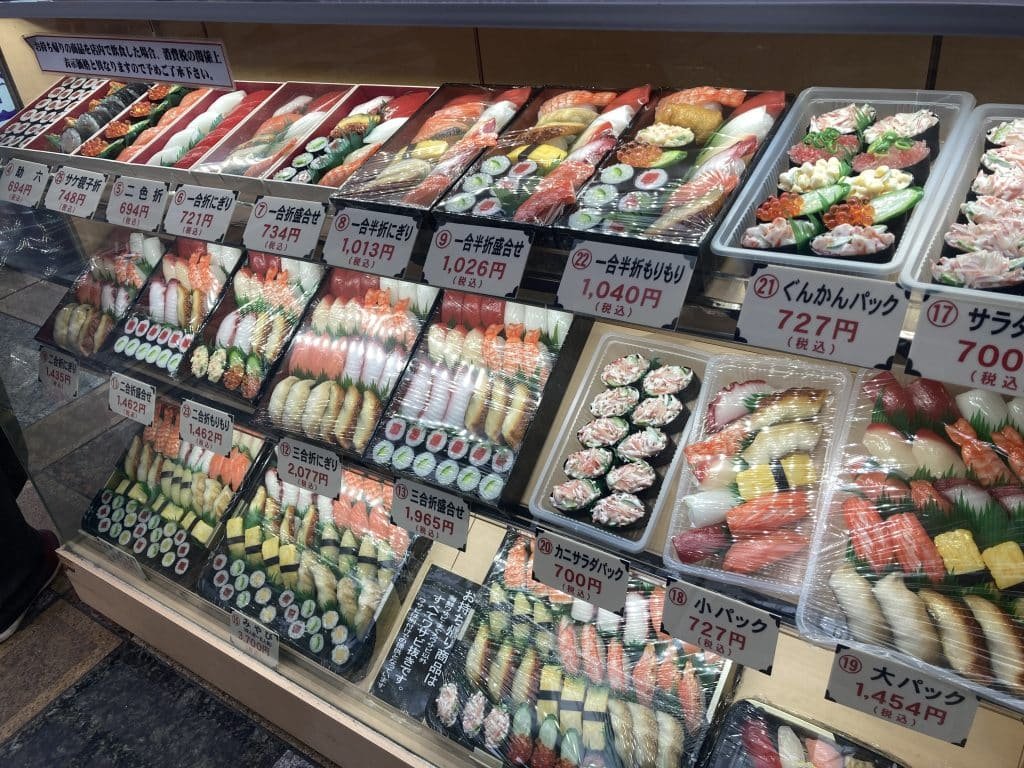

If you can believe it or not these are plastic! ↑ (I wouldn’t recommend eating them!) As tourists swarm back into Japan post-pandemic these food replicas are popular as souvenirs and they can be found at a number of shops in Namba and Dotombori which offer classes on how to make them as well!
To show you the craft of making food replicas here’s a video of 73 year old Takeuchi Shigeharu who creates in the traditional wax style. He has over 53 years of experience! Watch a few minutes of this, even if you don’t understand Japanese it shows the process!
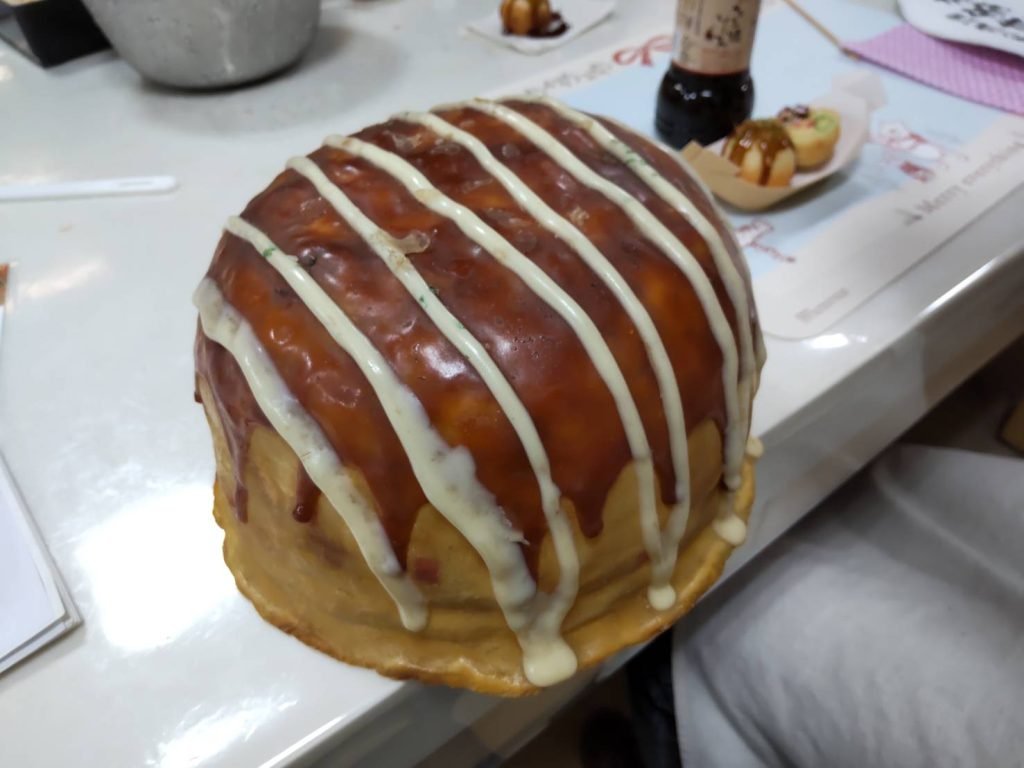
Everything he makes is so realistic! On the other hand, this is a GIANT takoyaki food sample! The kind that can be found at Kukuru Dotombori Konamon Museum in Namba. In addition to eating takoyaki on the 1st floor you can make FAKE takoyaki on the 3rd! The one that I crafted for myself wasn’t quite this big, but have a look! ↓
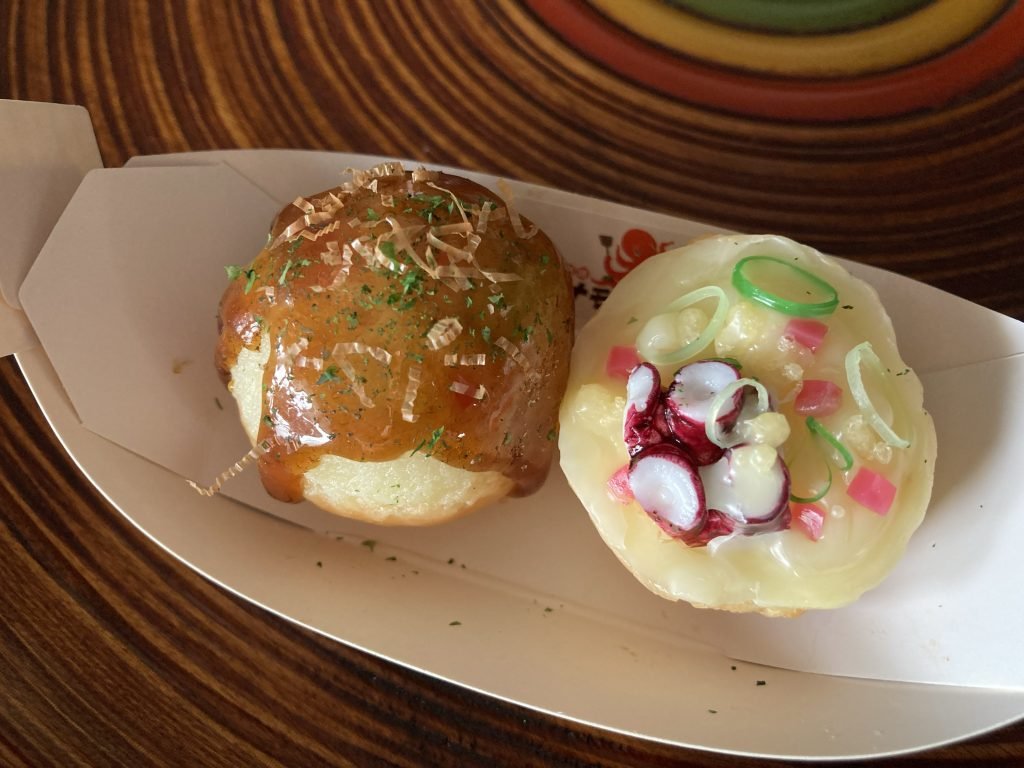
These are made with wax, plastic, and gelatin. The two people who were making takoyaki at the next table came all the way from Tokyo to try their hand at fake food creation, so you can see these are popular with domestic tourists as well! (Don’t worry, they have English instructions for tourists!) Before I say more about Konamon museum, I want to tell the story behind food samples like these, because they really are works of art!
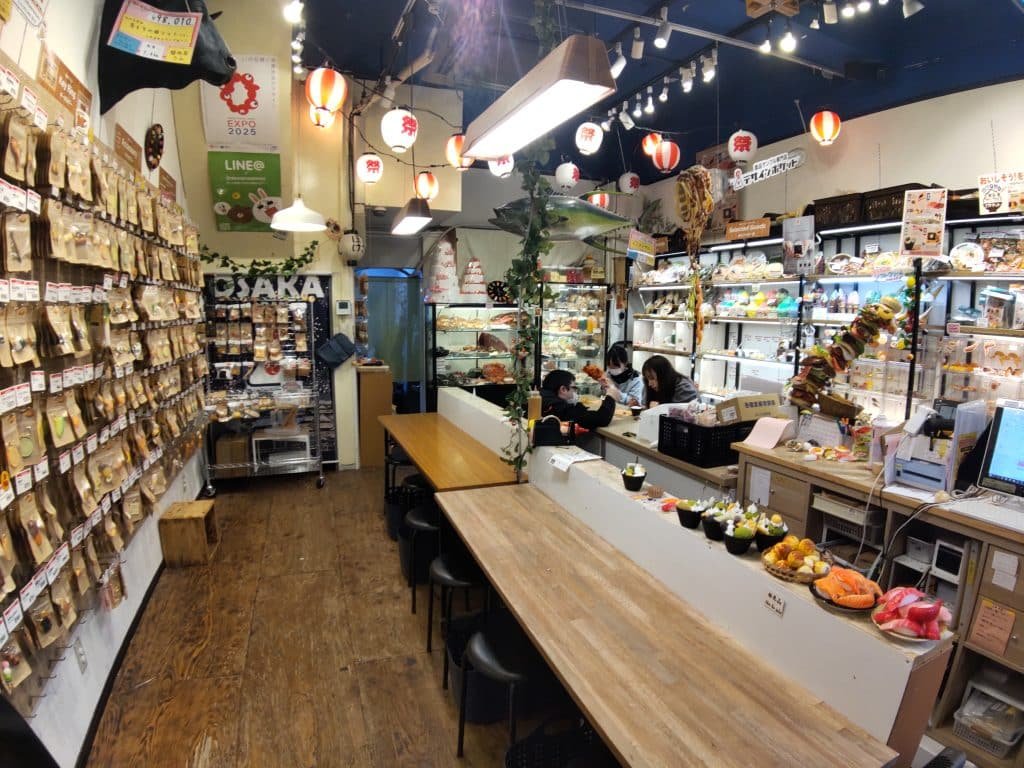
When visiting a store in Namba I overheard a customer ask the owner to create a wax version of Kansai’s famous Gozasoro Imagawayaki and she replied “yes I can do that, just bring it in for me first.” I was impressed. This is part of their (secret) process. At this store in particular no photos were allowed -perhaps to protect trade secrets. It is said that they make a mold of the object itself, but that’s just one small part of it! In this era of digital photos and AI art, this analog art is impressive.
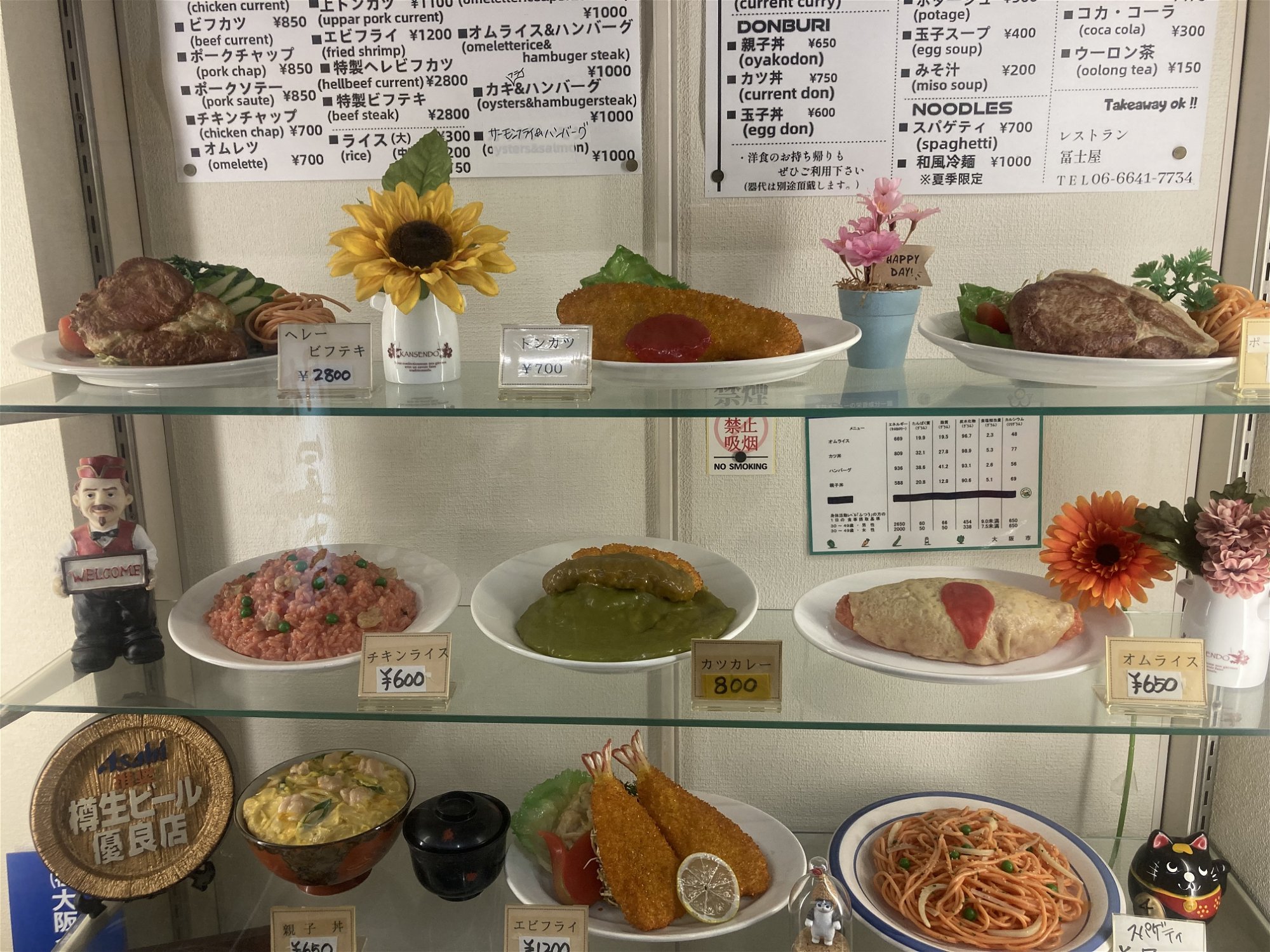
Some historical bits
This is a restaurant display from a Showa “Western” style restaurant in Nishinari Ward, Osaka. ↑ There are many interesting theories about where food samples started. One story mentions Takizo Iwasaki in Gifu Prefecture. A piece of wax fell from a candle into water and he thought it looked like a plum blossom. He realized that with wax he could recreate food dishes! And thus, food sample (“Shokuhin Sample”) was born!
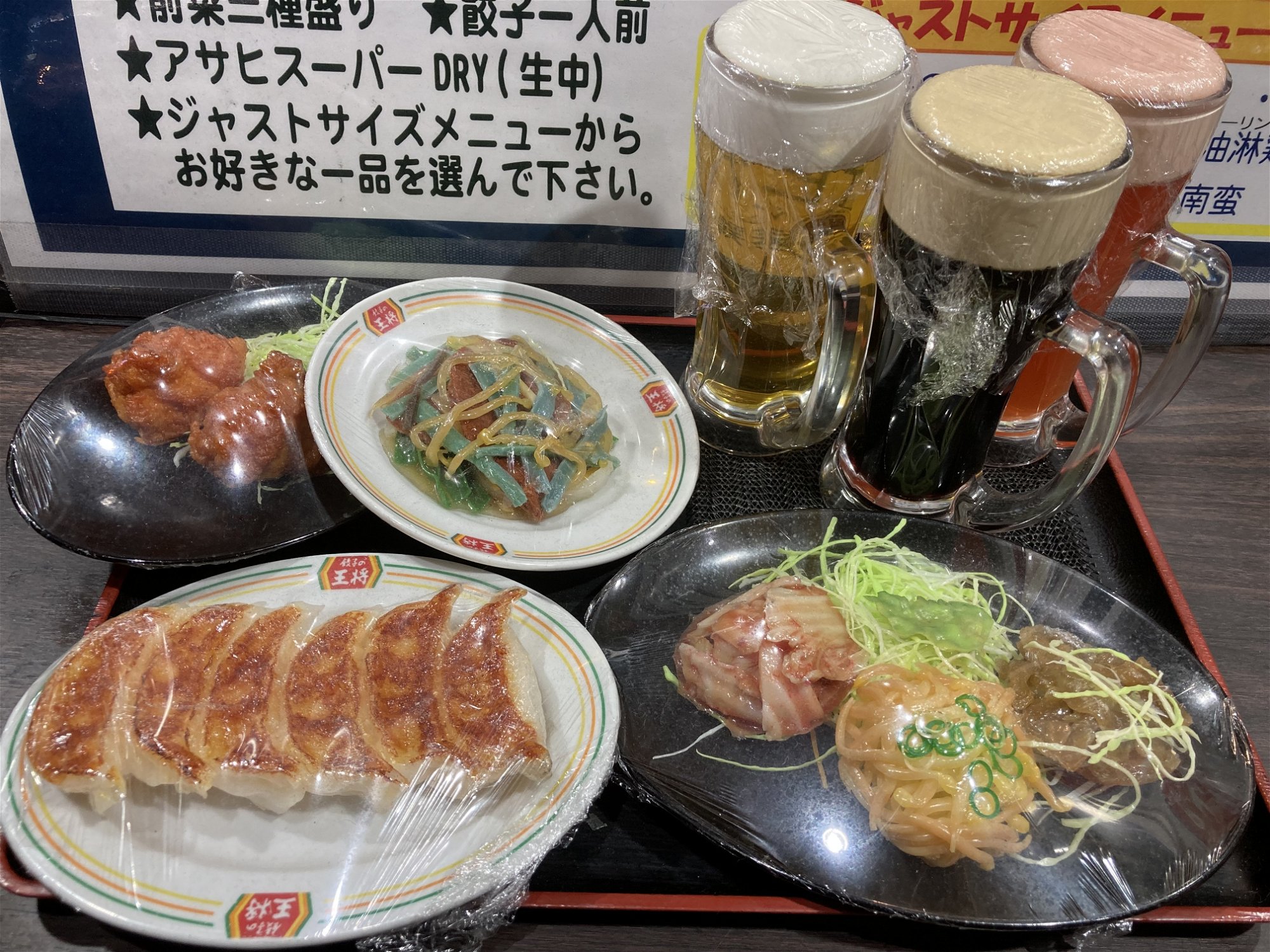
In another story, an eel restaurant owner approached an anatomy model maker who had constructed a wax liver and said “if you can make those then please make a wax “kabayaki” eel for me!” He wanted a new way to draw in customers.
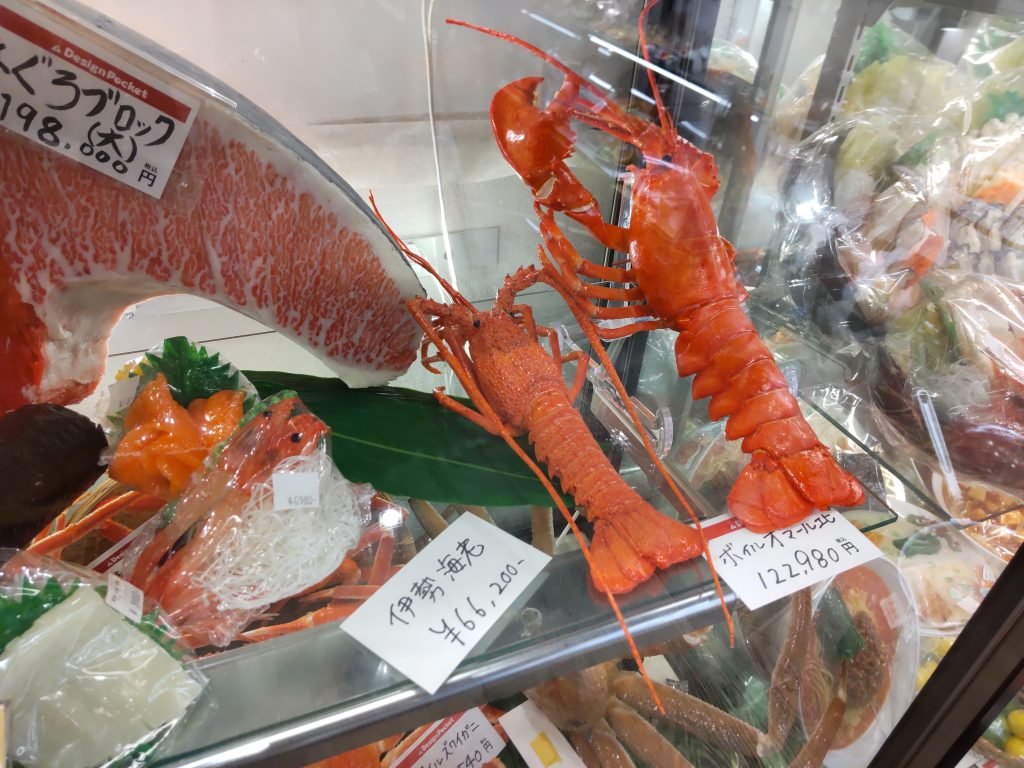
The anatomy expert was onto something and started a business, he created “Saito Samples” which still exists in Tokyo’s Kappabashi a place famous for selling cooking implements used in restaurants. Over the course of my journey to find food sample stores in Osaka, I was led to the “Kappabashi of Osaka” which also has shokuhin sample and restaurant tools! But we’ll cover that more later!
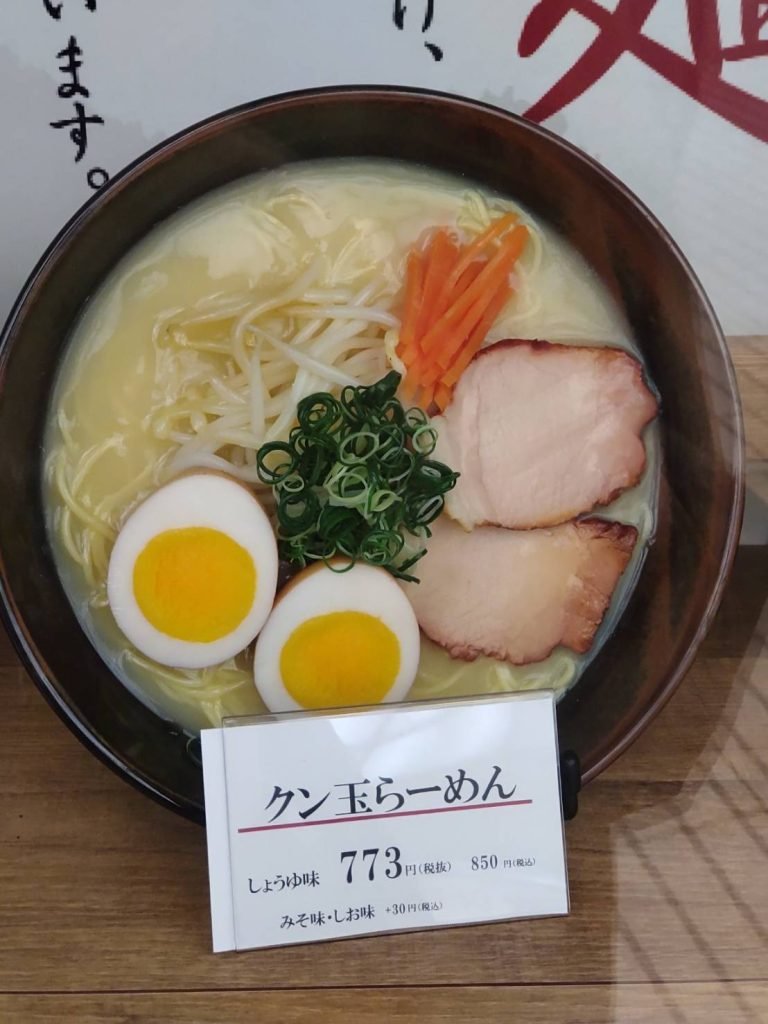
It is said that food replicas really took off once it was commercialized, which happened RIGHT HERE in Osaka In 1932! That means it was mass produced and gained popularity starting in Kansai! How exciting!
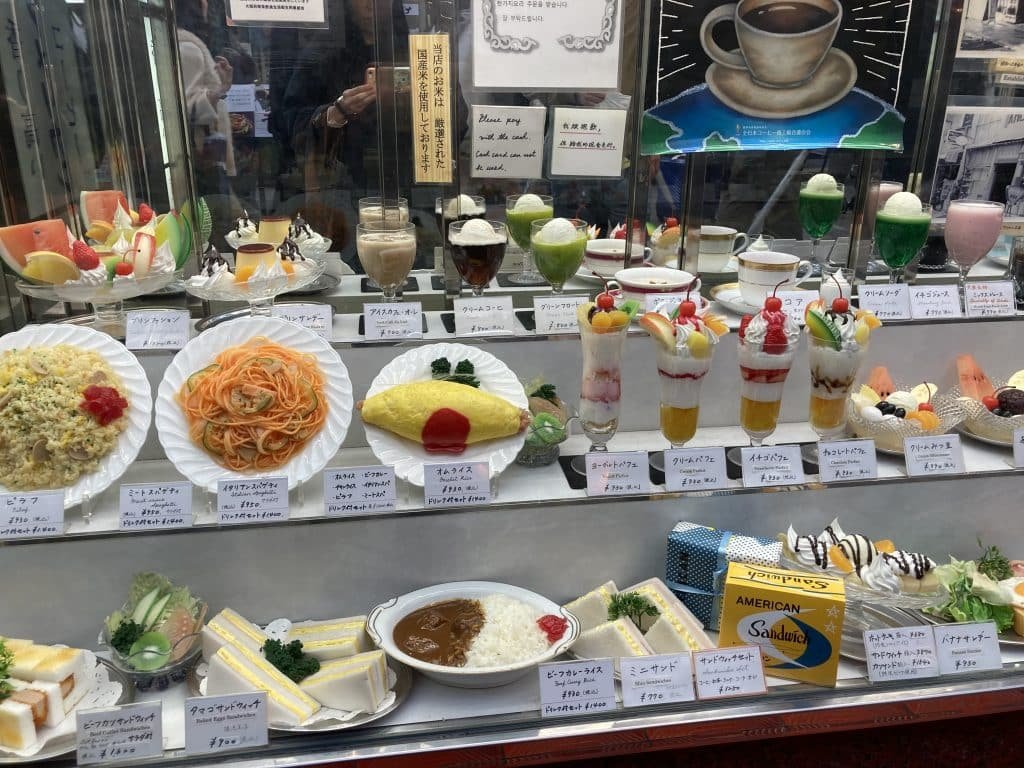
Like the above kissaten (retro cafe) “American” in Namba, shokuhin samples gained popularity decorating western-style restaurants like these. European/American style food was banned during the war but surged back into popularity later on. As these unfamiliar food genres entered the Japanese scene it was important to show people what they were going to get! And what better way to do that than with these sculptures!
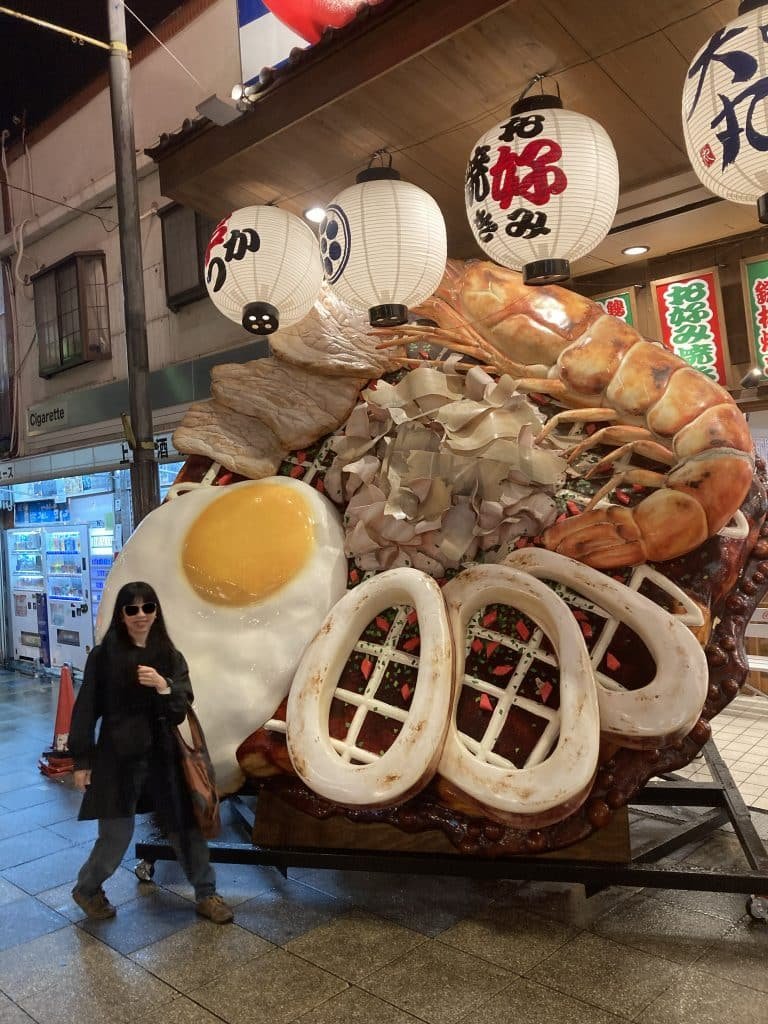
But Osaka is famous for making GIANT food samples. This is perhaps taking it a bit too far! ↑ This is a gigantic okonomiyaki! I’ve never had an okonomiyaki with a fried egg and whole shrimp on top, but it looks delicious!
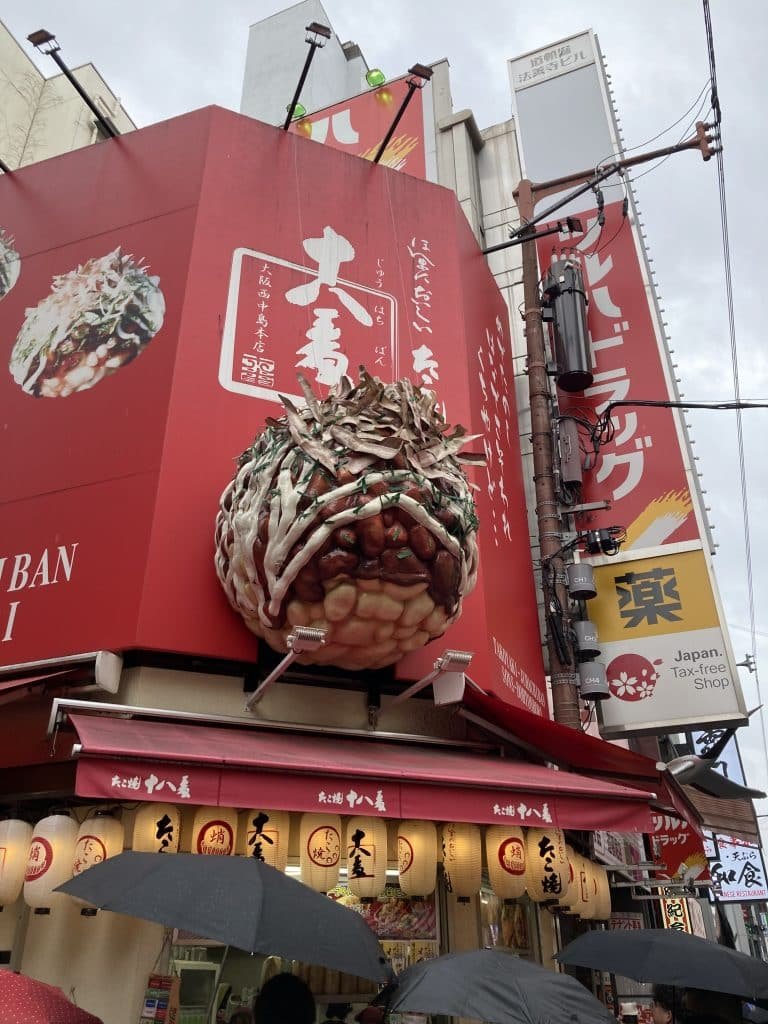
Sennichimae Shotengai

But my first destination was a food sample shop called Design Pocket in Namba. It was in the Sennichimae Shgotengai (a fascinating shopping arcade in its own right!) I had mentioned previously that I found “The Kappabashi of Osaka” -a place to buy cooking implements, it’s located here!
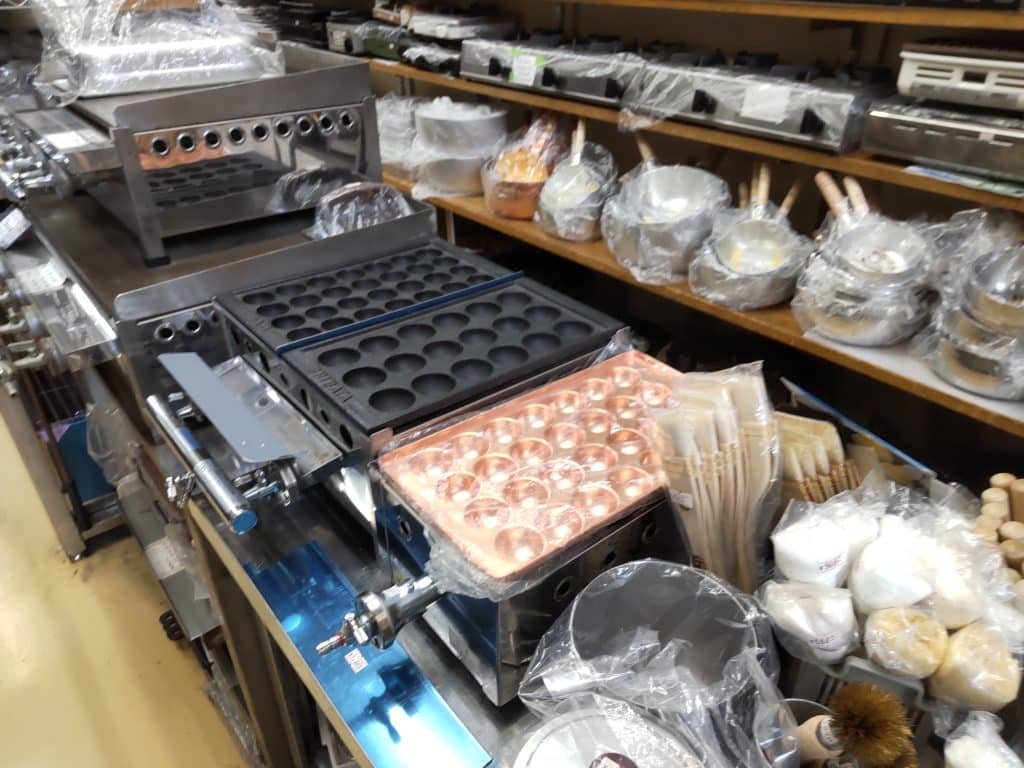
If you want to start a takoyaki shop, this is where you would go! You can see the tools on the right ↑ are for brushing on sauce! These are all specialty tools you can’t buy anywhere else easily!
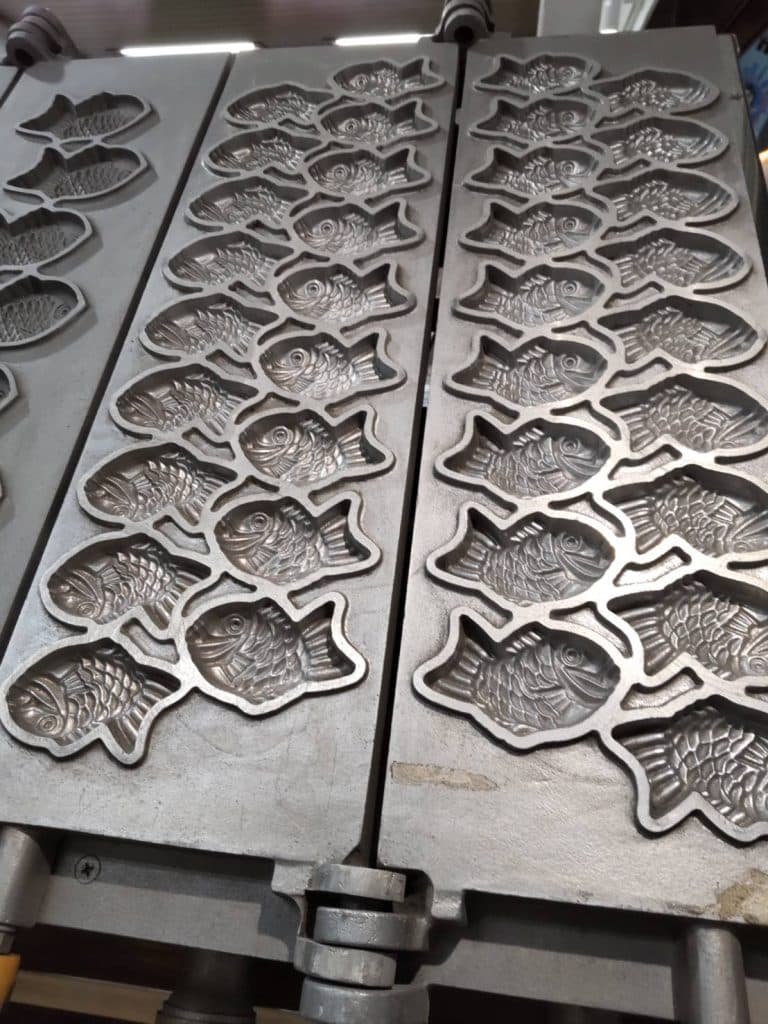
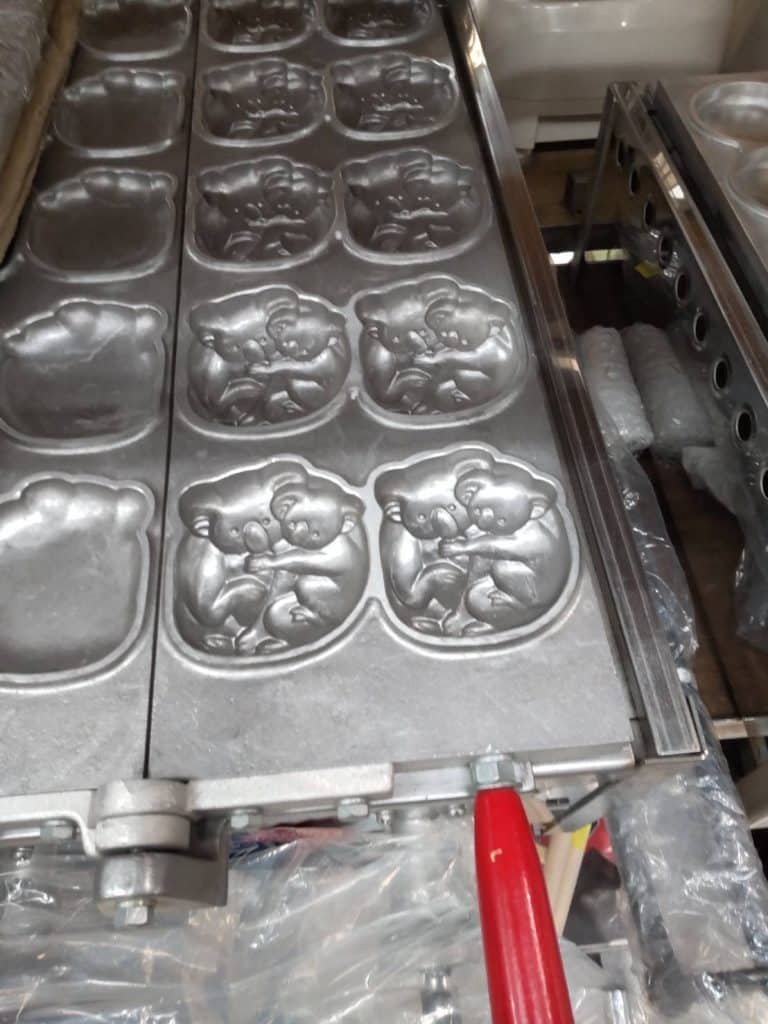

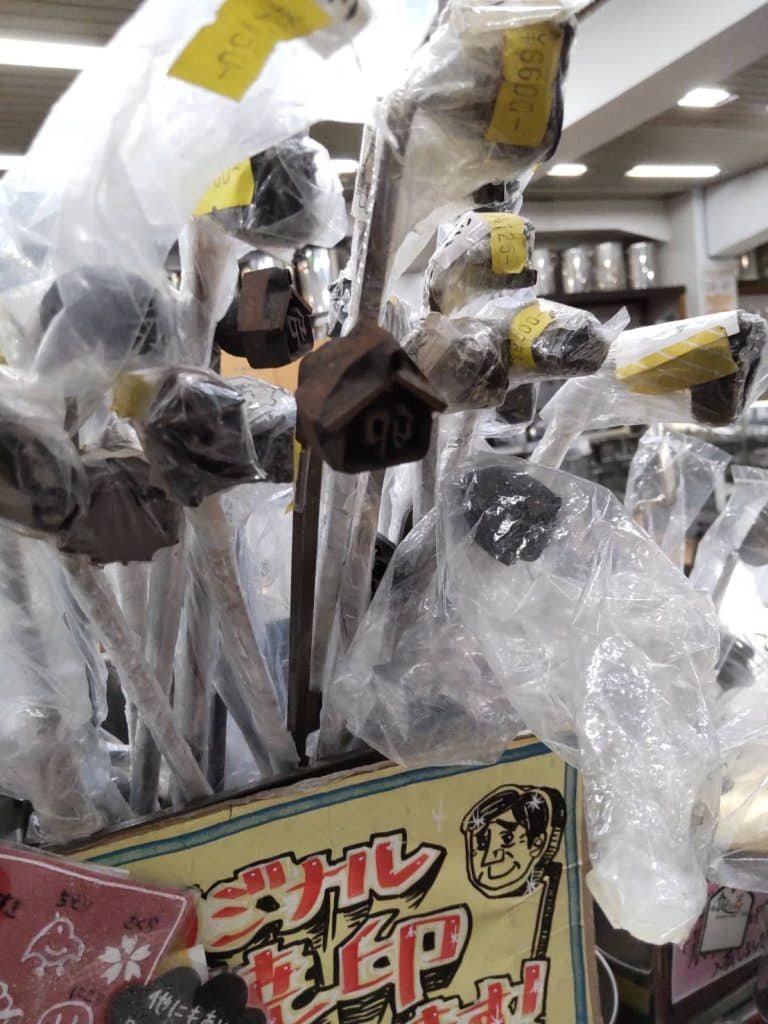

And if you’re in the mood for laughs, right outside the entrance to the shopping arcade is the famous Namba Grand Kagetsu which is Osaka’s (and Japan’s) famous comedy theater.
Food Replica Specialty Shop: “Design Pocket”
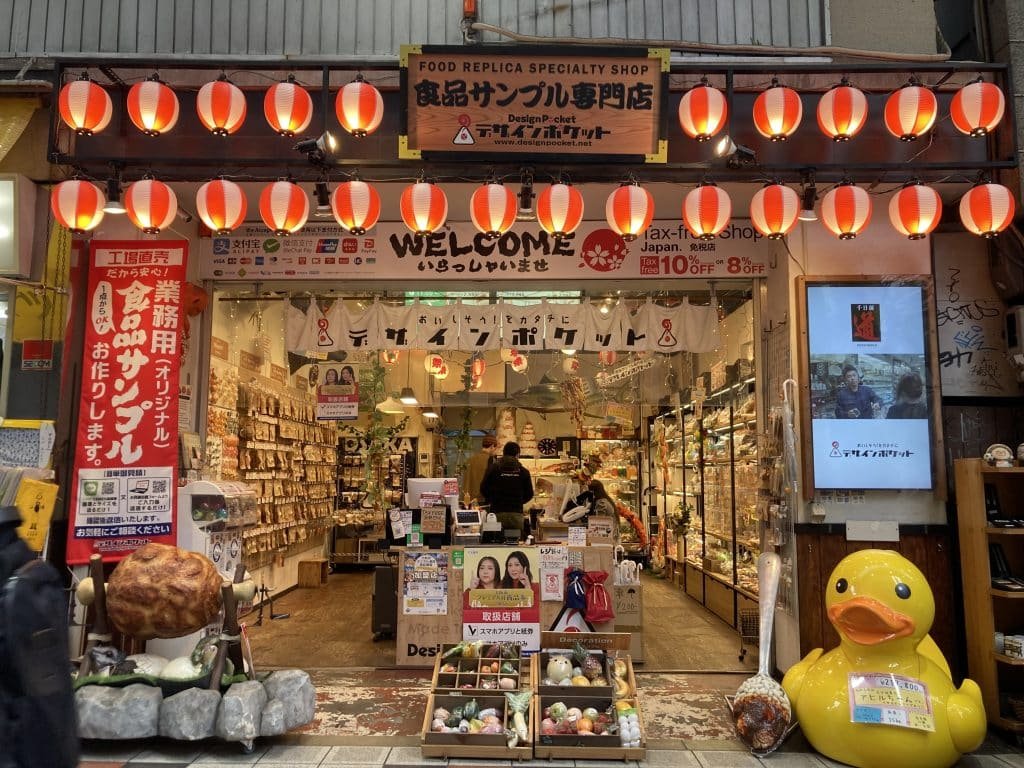
But I’ve strayed off topic. I finally reached my main destination which was Design Pocket. I was interested in checking out the store because they had keychains, magnets and amazing displays! I had been collecting shokuhin sample magnets since visiting Tokyo’s Kappabashi and I was looking to add to my them.

Here’s my collection! I bought the ebi and chikuwa at Design Pocket in the 100 yen corner! Very cheap. ↑
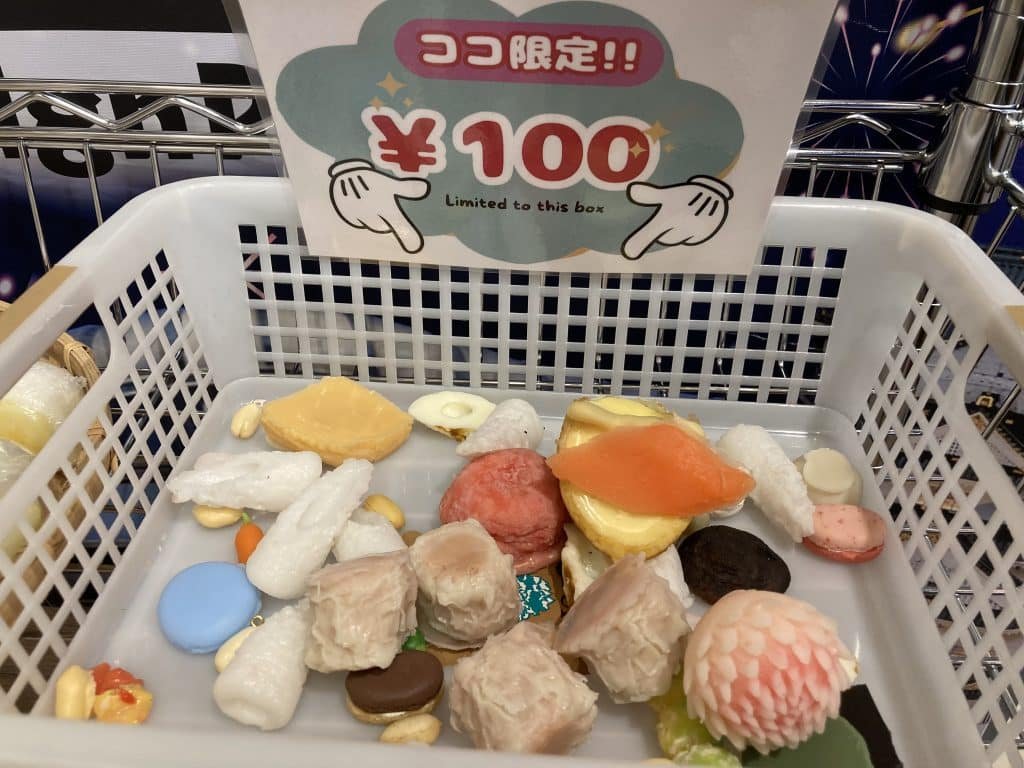
Some of the other pieces in the discount bin! ↑
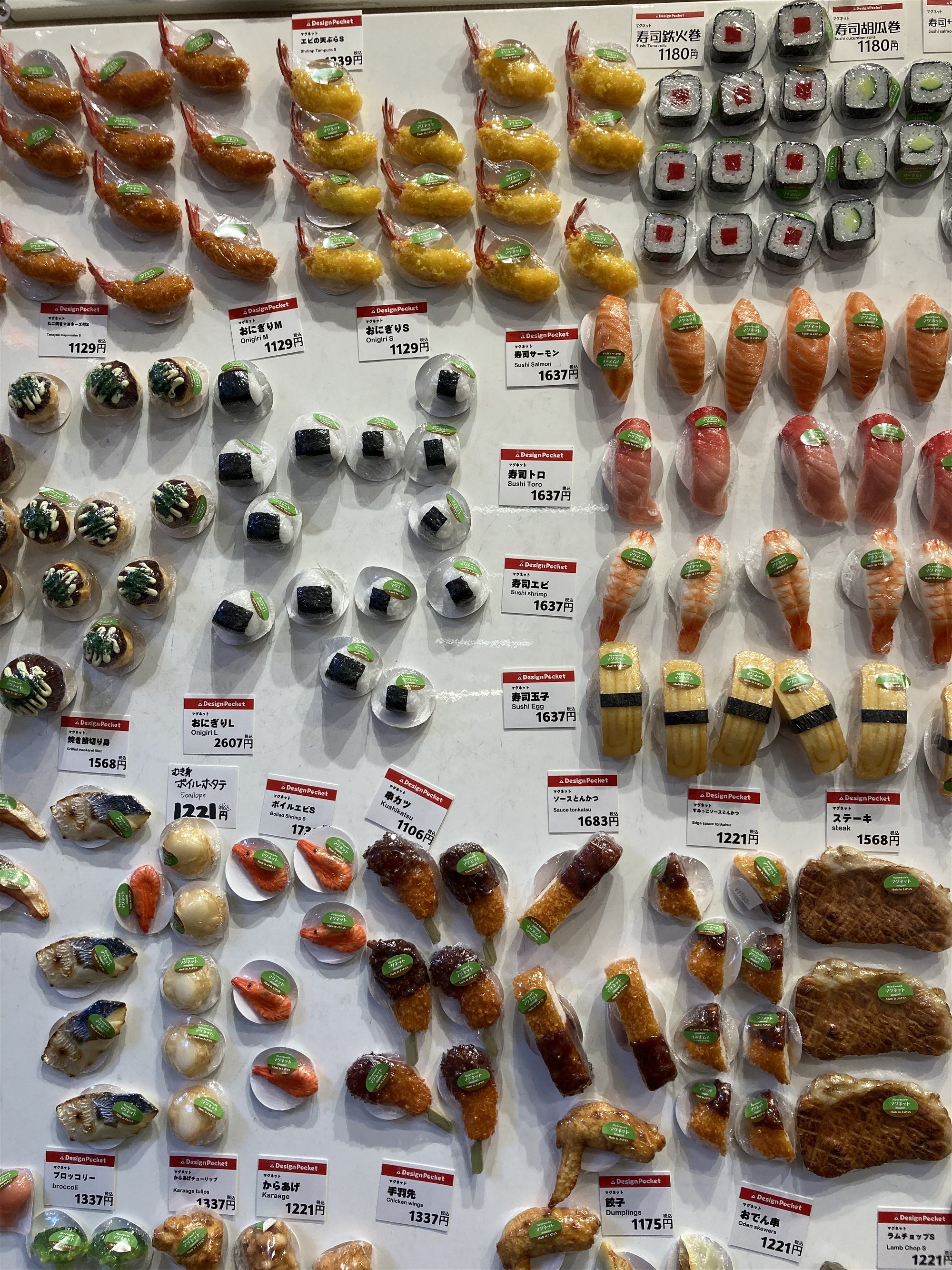
Here are some other great magnets in my favorite section in the store. As you can see there are okonomiyaki, salmon, melon-pan, etc. I love that you can stick these to the fridge and appreciate them every day! They won’t get damaged like the keychain items, they last a long time! I recommend buying these for a souvenir!
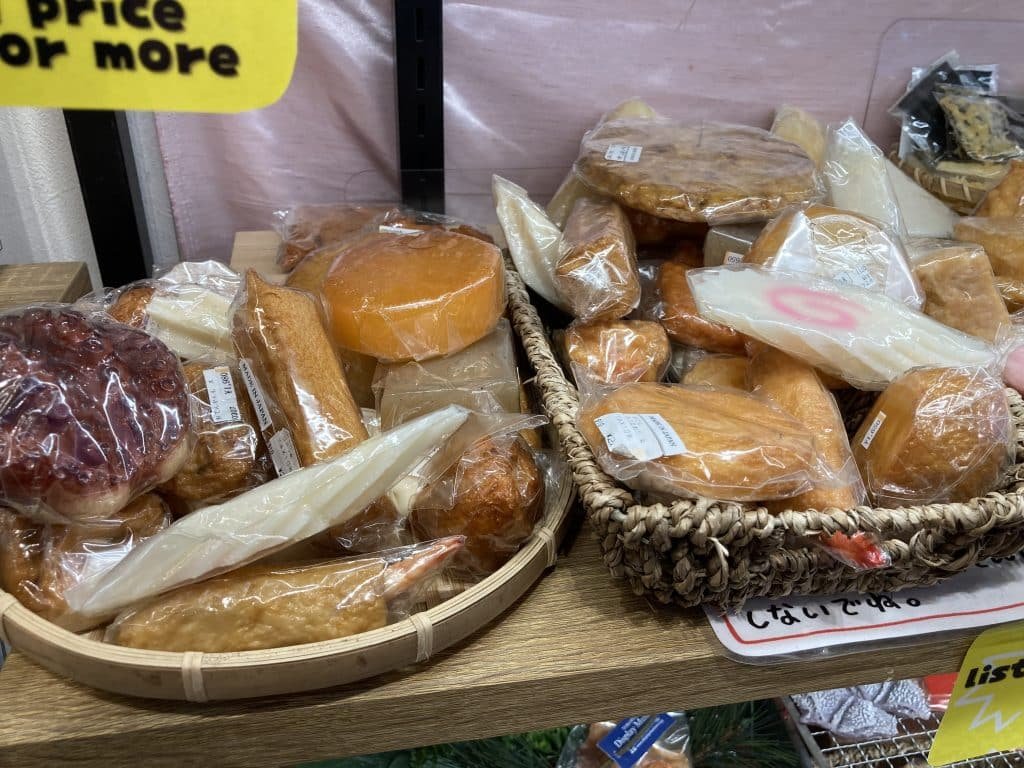
I bought some for my American friends and family and everyone loves them because they are handmade by traditional Japanese craftsmen and you could never get them in America! People may throw out a store-bought gift but these magnets are unique and one-of-a-kind! And by buying these you are supporting these artisans, it’s a win-win! These were not as cheap as the 100 yen ones. Since these are works of art and made by hand they can get very expensive!
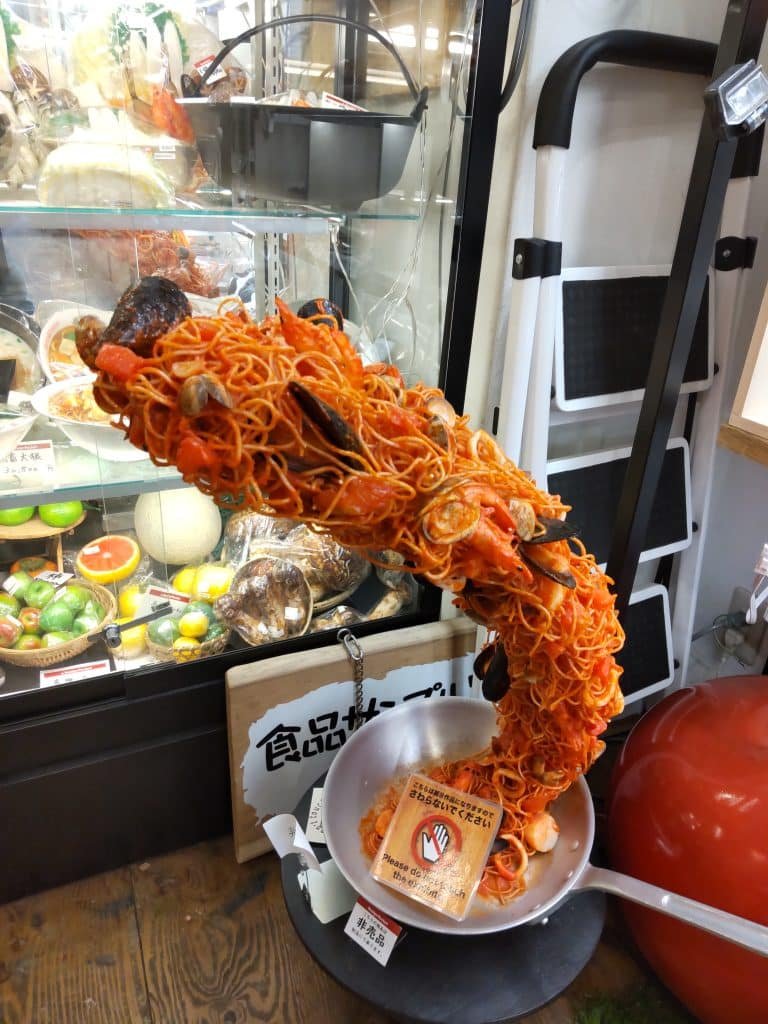
Here is a giant pasta monster -but I think it’s just to draw in customers!
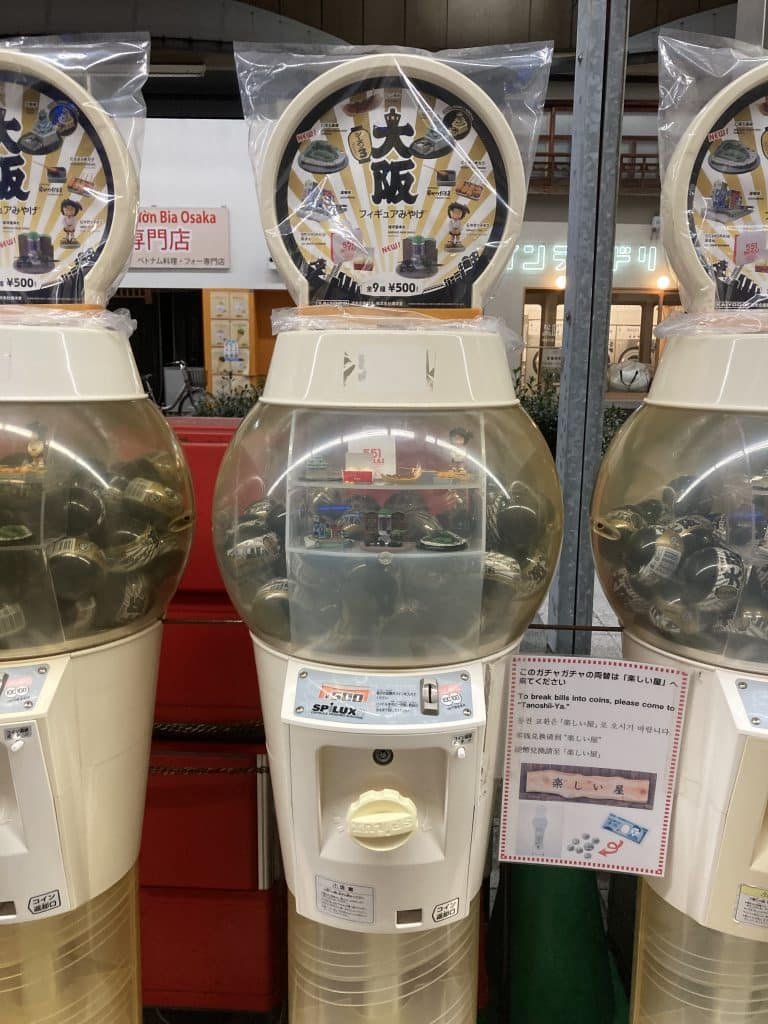
You can also buy gacha-pon capsule toy food samples! This is my #2 recommendation for souvenirs! ↑
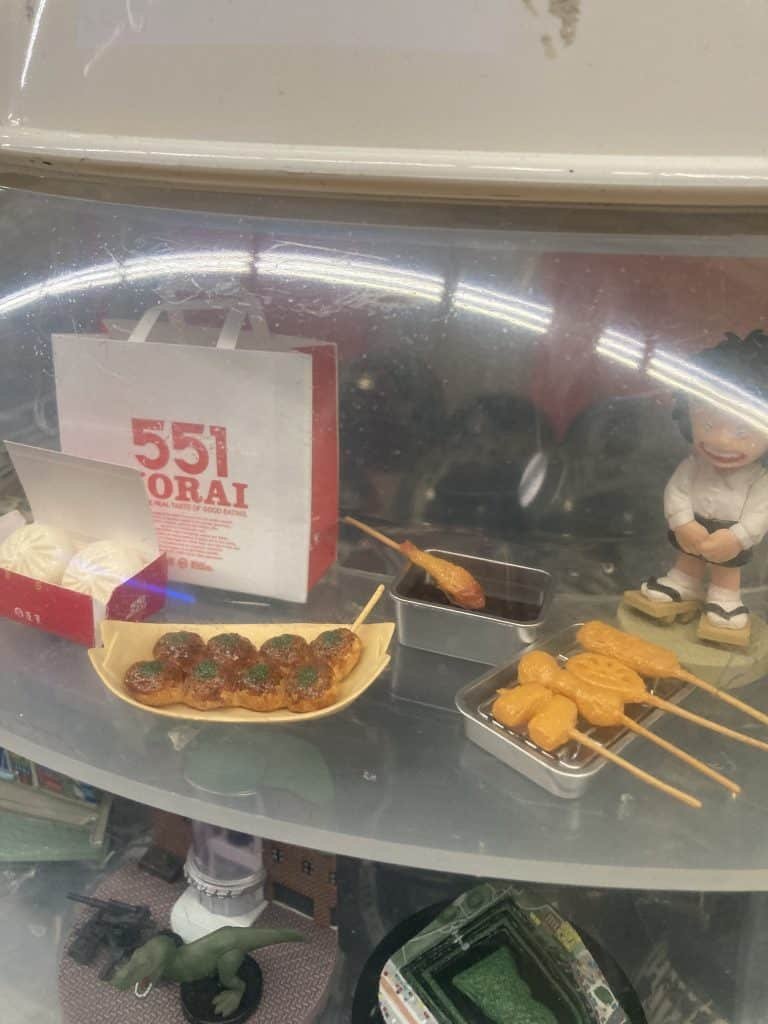
These are cheaply priced! They’re mini versions of the famous Osaka restaurant food samples -much smaller than the magnets! But be careful, with capsule toy machines you never know which one will come out!
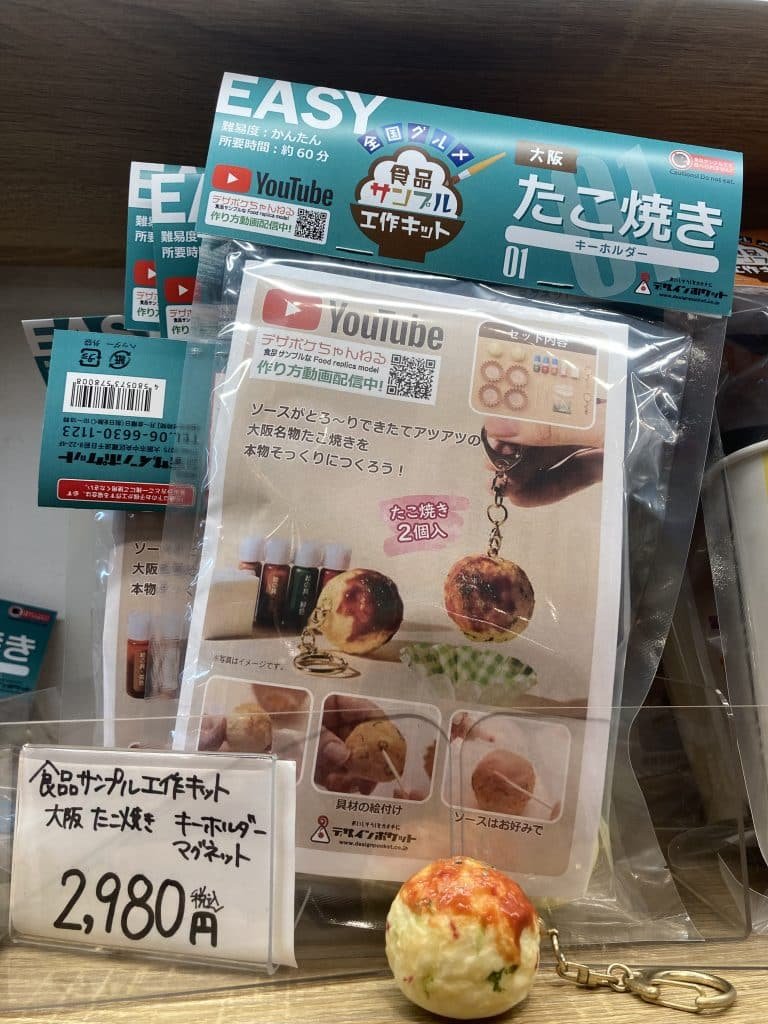
For a little more money you can buy a kit to make a takoyaki keychain at home! This is a Design Pocket original so it’s a steal! It would be good for a kids birthday party activity or arts and crafts homework assignment! (Adults love them too!)
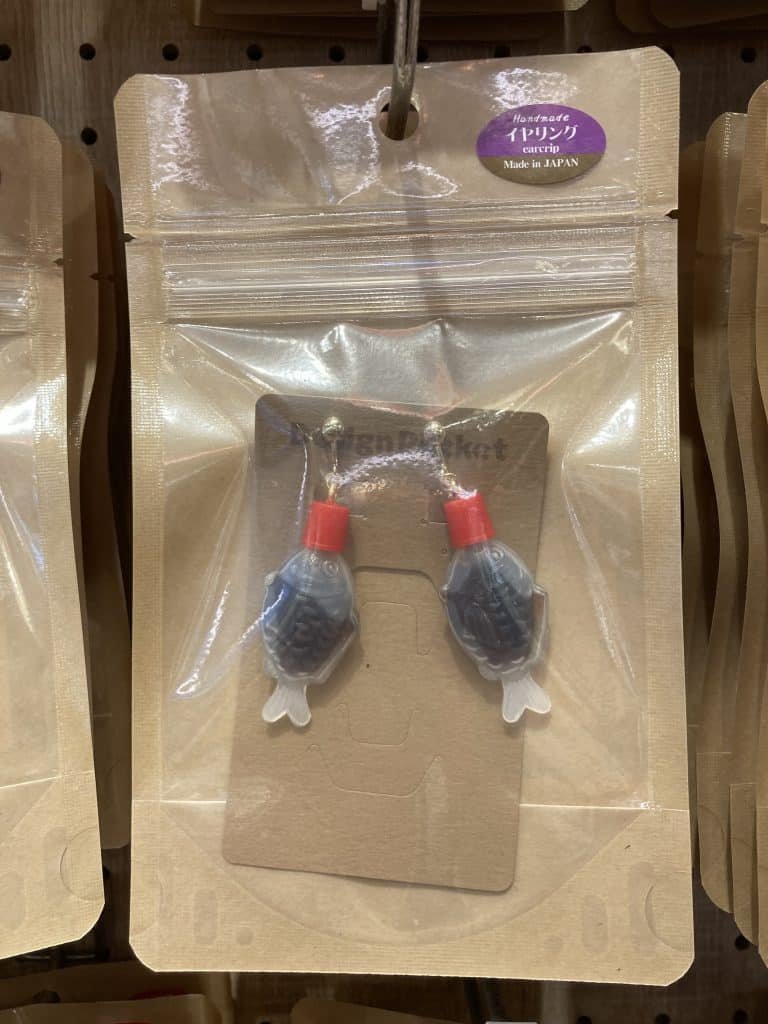
↑ These are little fish soy sauce case replica earrings. I wouldn’t wear these myself buy I thought this was a very creative idea! It even has real liquid inside (food coloring?)
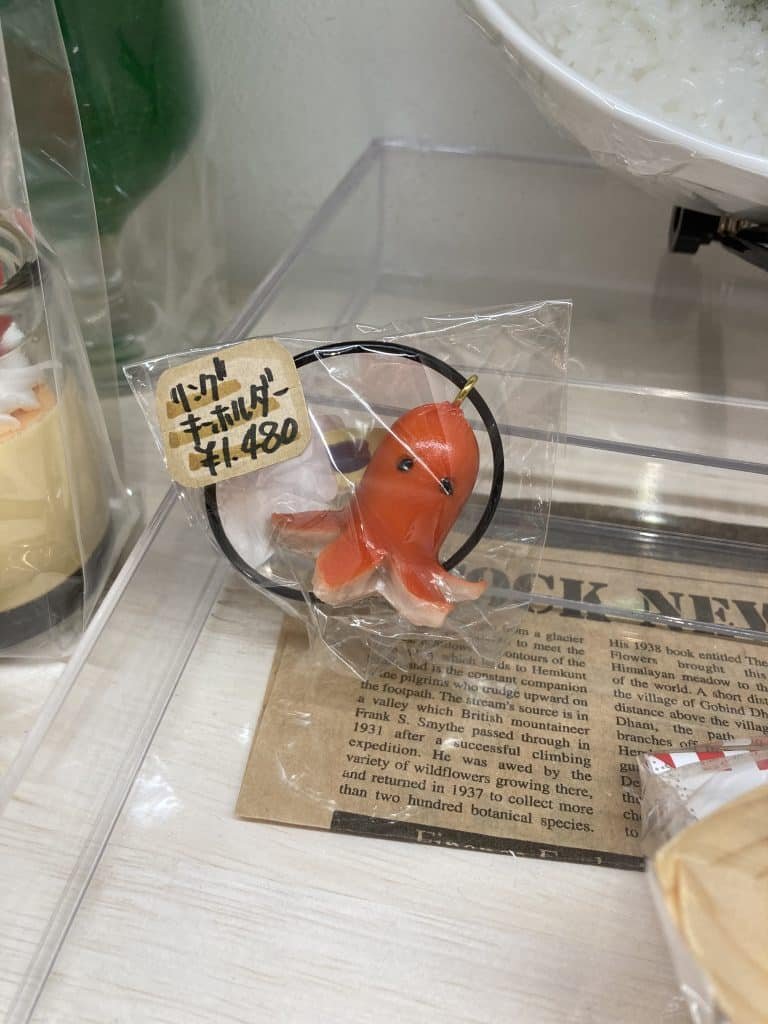
Only Japanese would make an octopus-shaped sausage! Showa-era mothers famously made cute “tako”-shaped dogs like these! You cut a slice into the weiner, boil it, and it transforms into a sea-creature in the school lunch bento! Japanese people love to turn everyday objects into animals and cute creatures, it’s such a fun tradition! You couldn’t find it in America! It becomes the object of conversation or a joke! Osakan people love to make a gag out of everything so it’s a way to make new friends!

↑ These would be great for office-workers! They can clip a business card into the banana on their desk! They’re all hand-made! It would liven up a boring work day and bring a smile or a chuckle!
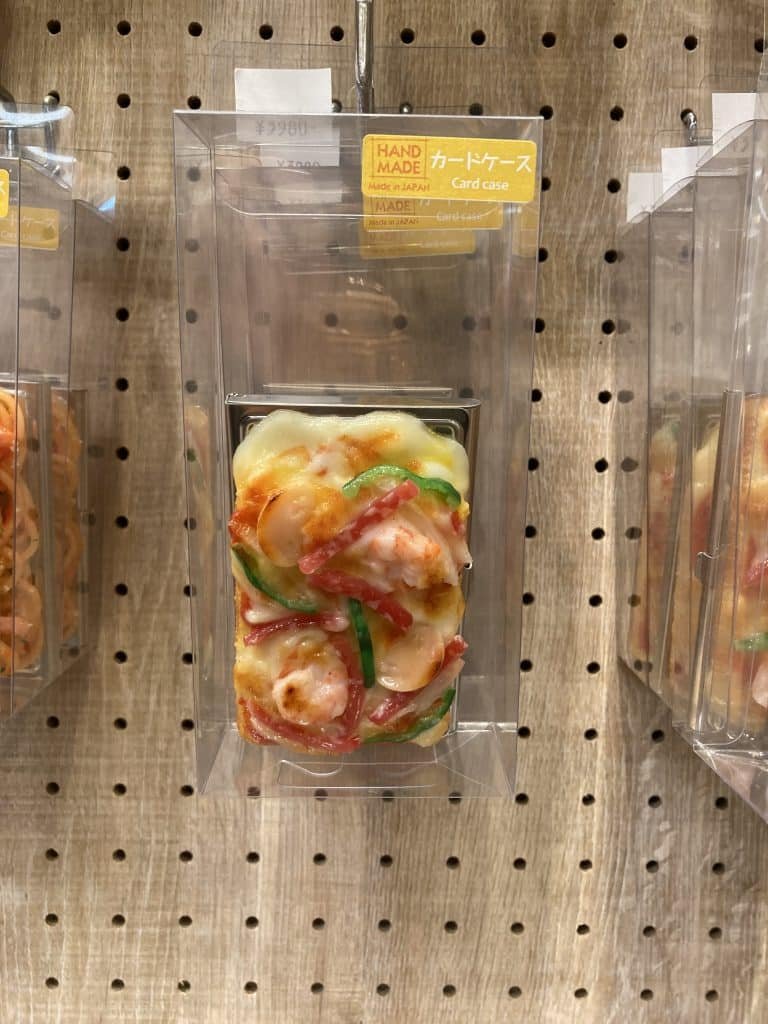

↑ These are business card cases. Exchanging a card can be stressful but this case would lighten the mood! It would be great for the owner of an Italian restaurant!

↑ “Yacchatta tamago,” it says which means “oops I did it!” And the next one says “Kimi made yacchatta tamago” which means “even the yolk got smashed!” I thought this was an interesting idea/joke!
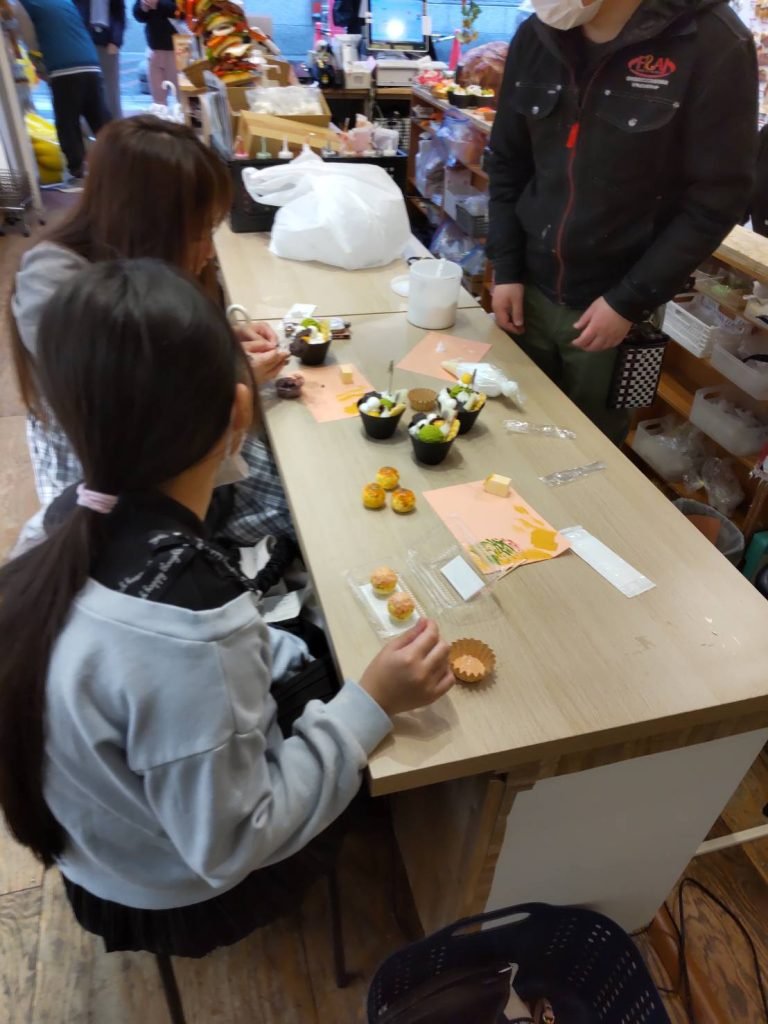
They don’t just sell food, while we were shopping the store staff lead a shokuhin sample lesson. The two girls doing the class were having so much fun, I recommend trying it out! ↑

Here are some of the things you can make in the class: takoyaki (keychain or magnet), sushi (magnet), and matcha parfait (memo stand.)
Iwama
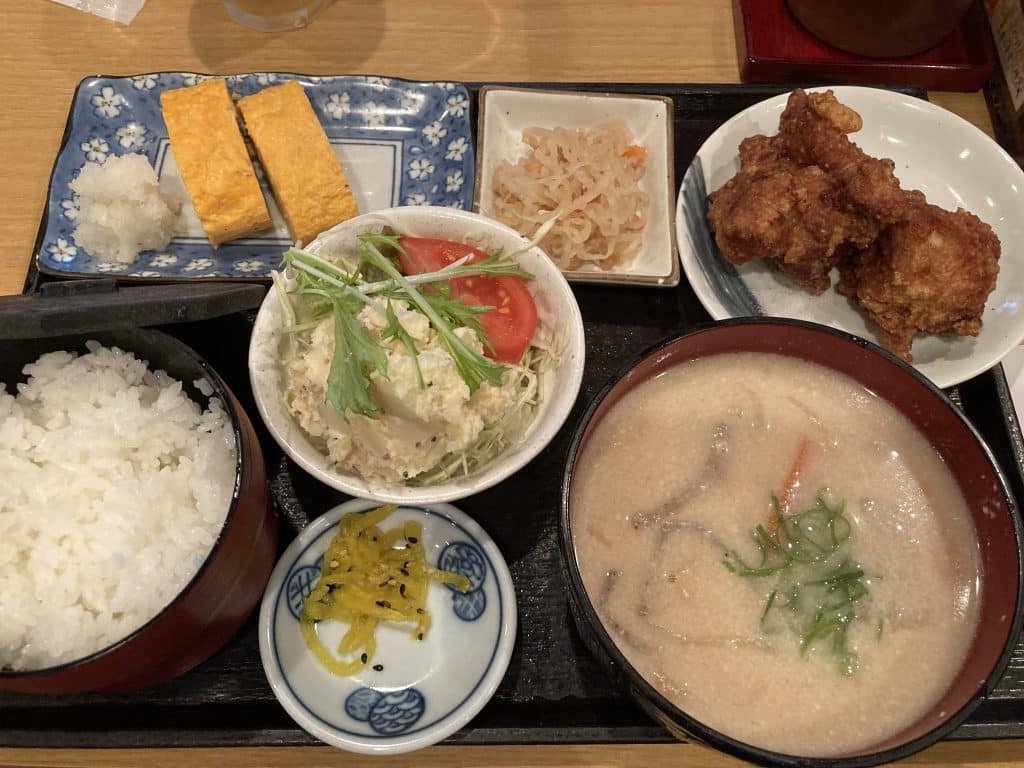
We were getting pretty hungry from looking at all the food replicas so we went to Iwama in Sennichimae which had a long line (so we knew it must be good!) As you can see from the picture, their food samples were VERY realistic! ↑
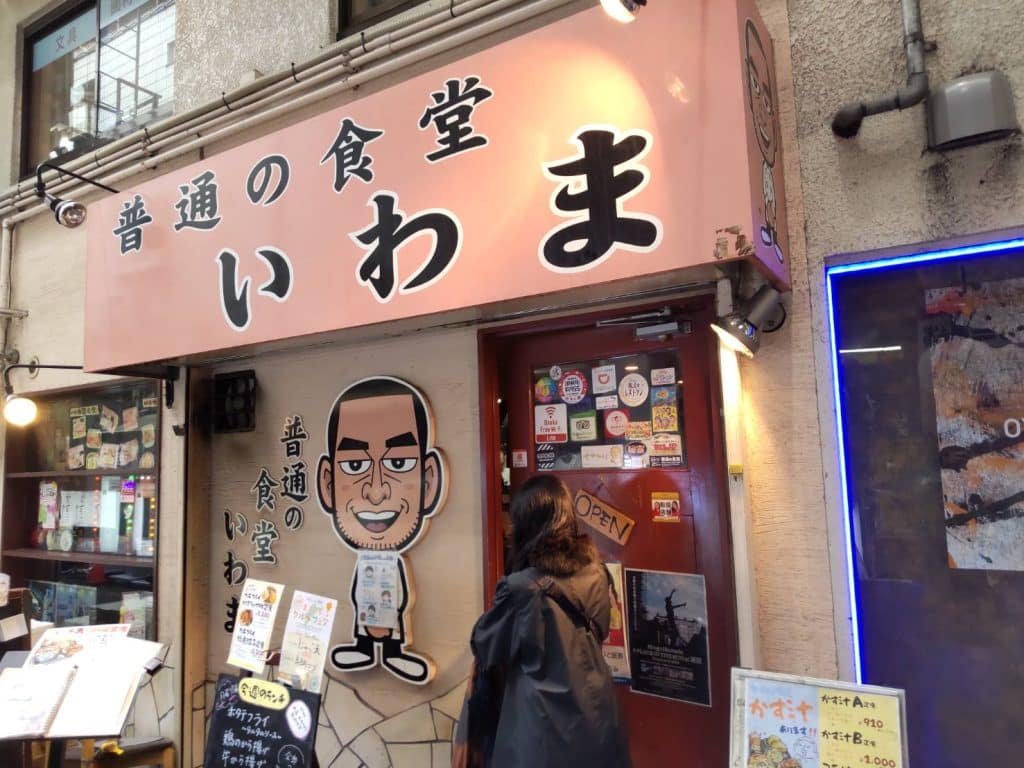
No, I’m just kidding. That’s a photo of our lunch. It was fried chicken, potato salad, Japanese omelet, and sake lees soup. It was very delicious and reasonably priced (around 1,000 yen.) I recommend it if you are in the area.
Konamon Museum in Dotombori
We had a reservation to make some wax takoyaki so we headed over to Kukuru Dotombori Konamon Museum in Namba
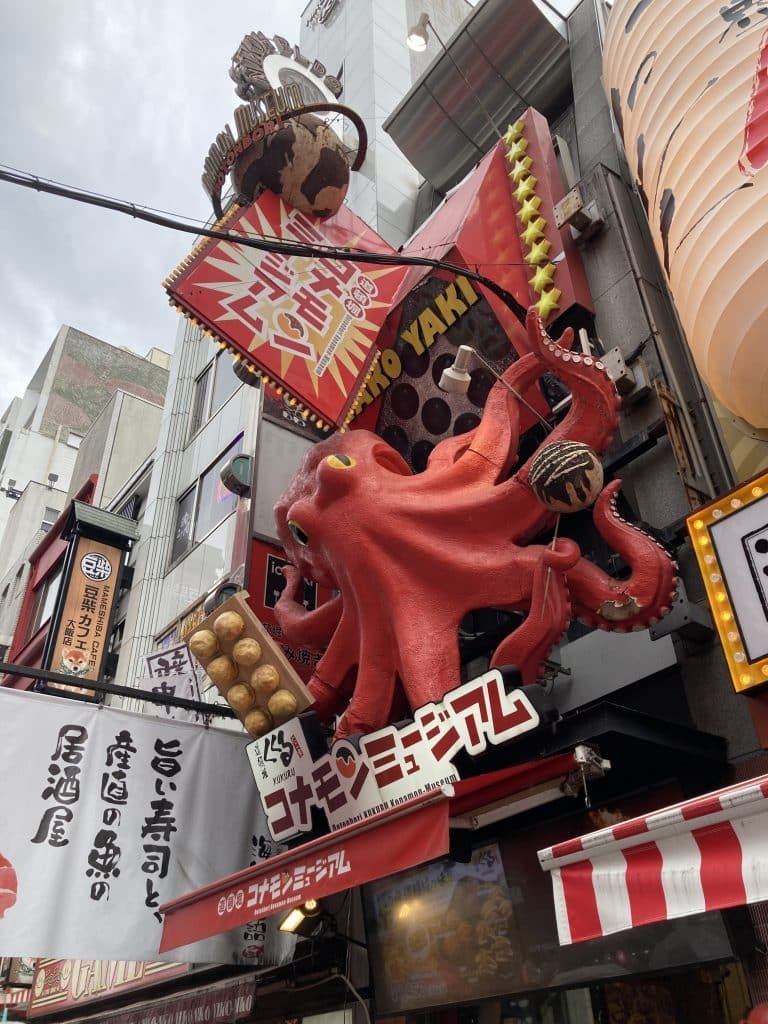
When you see the giant octopus you know you’ve arrived! (But knowing Dotombori there is probably more than one!)

The great thing about this place is not only can you learn to make wax takoyaki, but you can also make real takoyaki (I don’t recommend you eat the wax ones!)
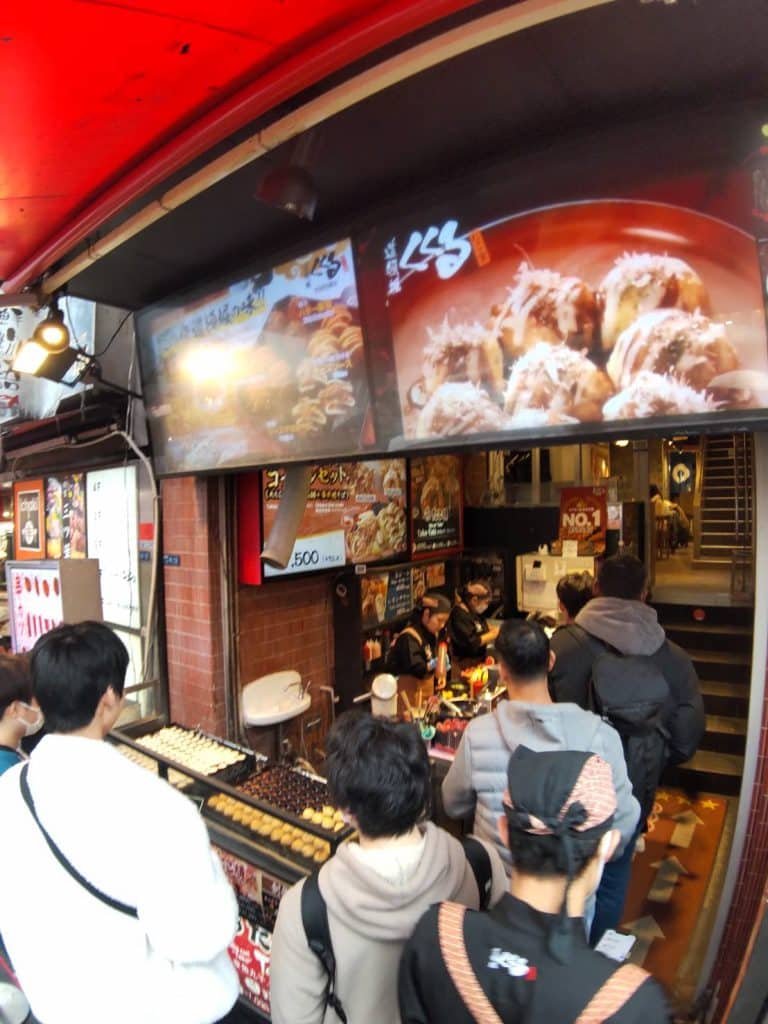
It’s a very popular place as you can see by the long line to get inside!

Let’s get started with the lesson! Here’s the “classroom” and teacher Inoue Sensei who met us with a smile!

The wax needs to be heated so we can make the takoyaki from scratch! Some other places give you the pre-made ones -but this is the real deal!
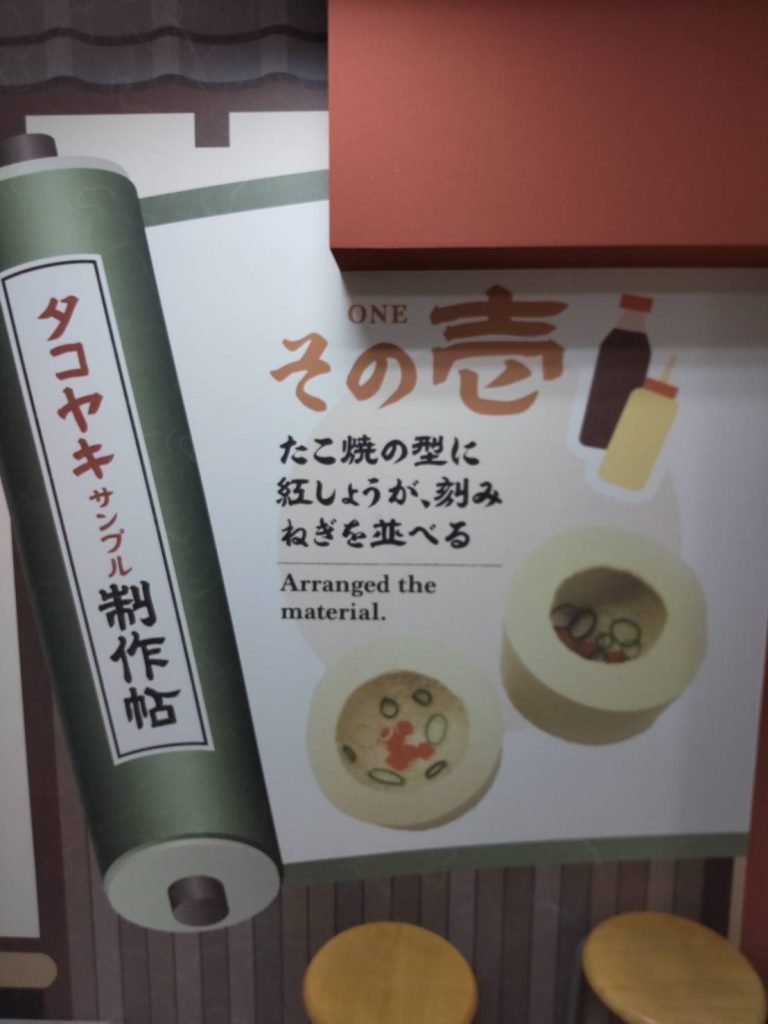
As you can see from the picture we arrange some takoyaki toppings inside the mold like so ↓
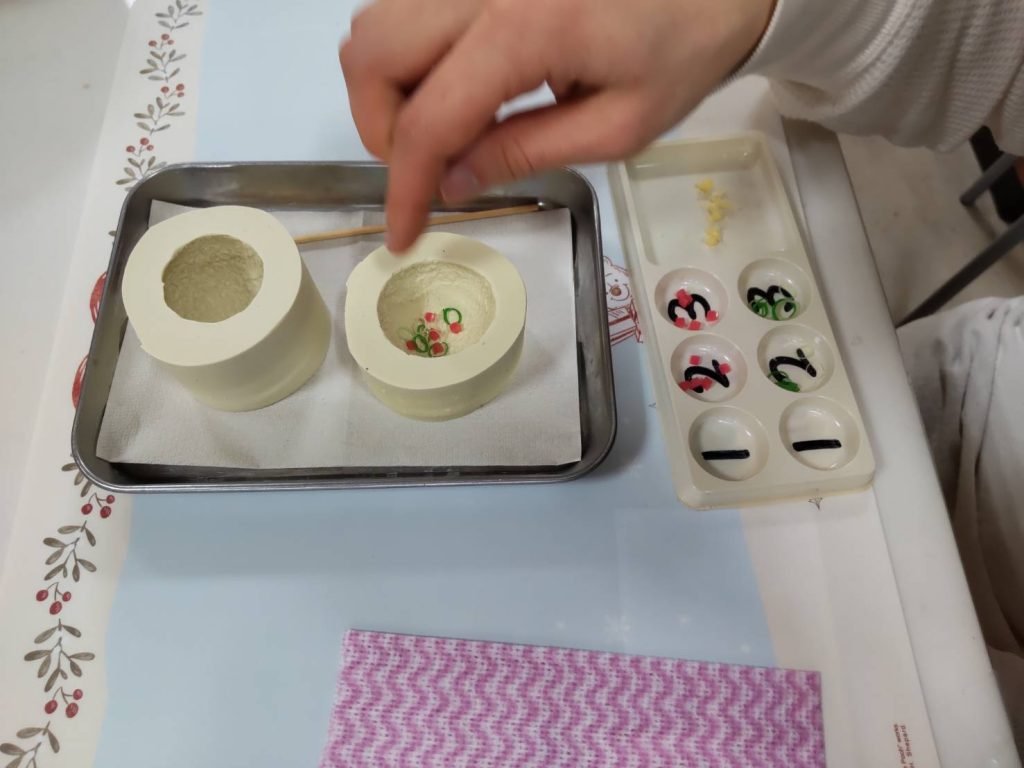
Then we pour in some wax ↓
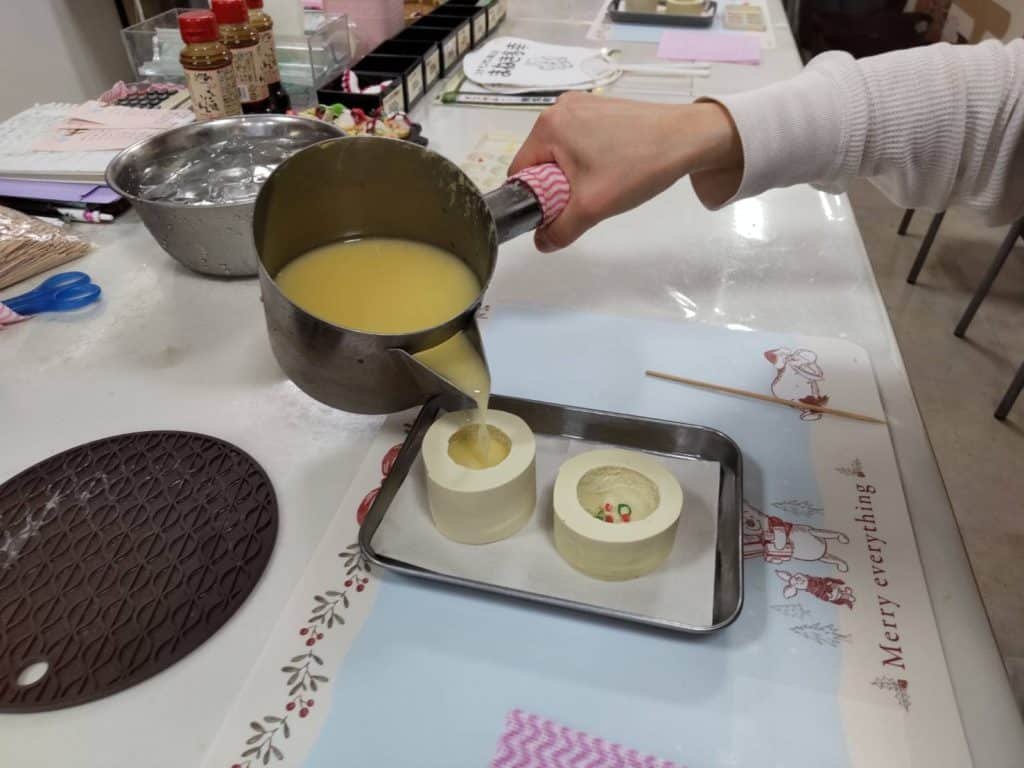
We put it in ice water to release from the mold and then…
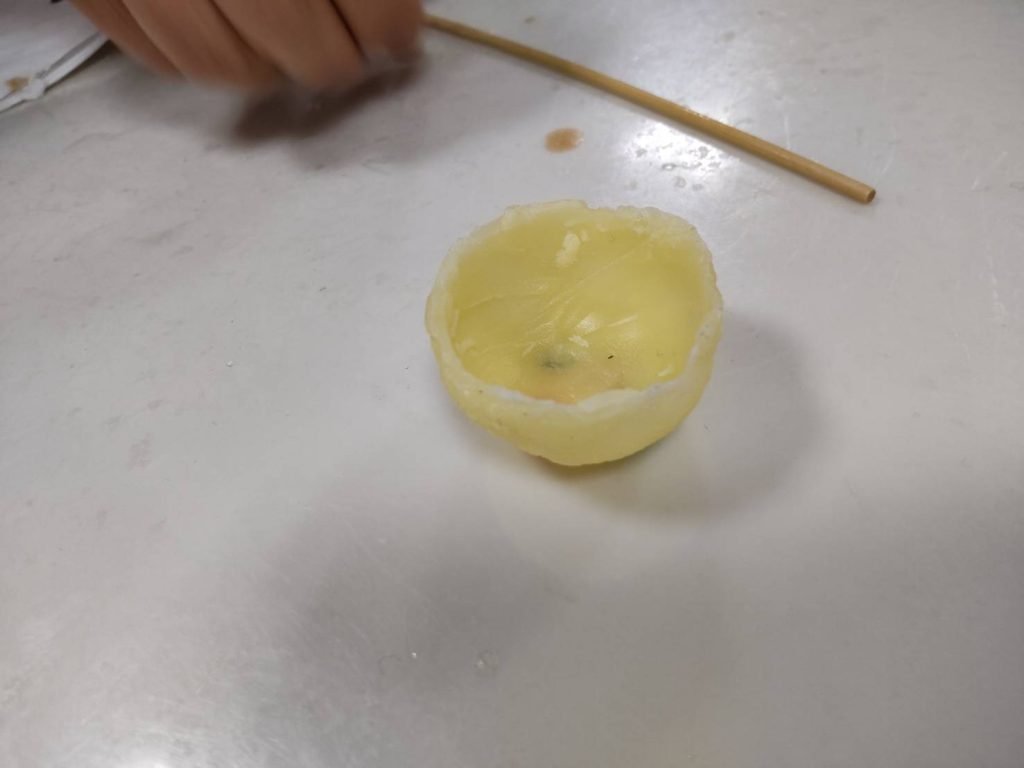
We get a nice takoyaki shell! ↑
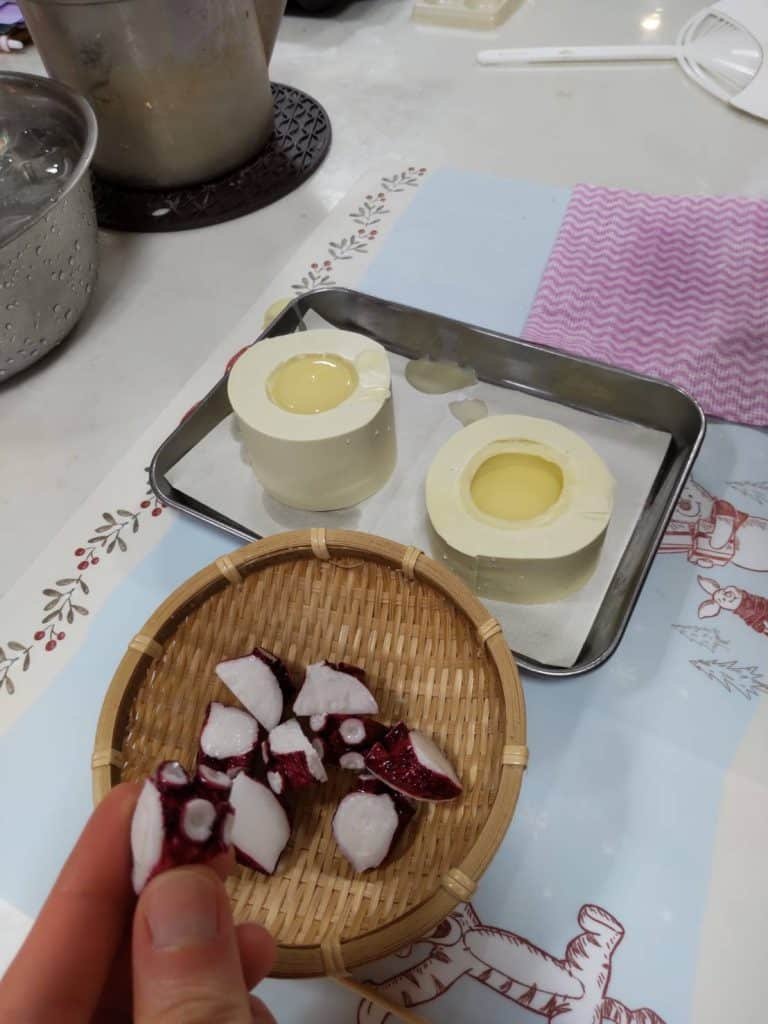
Let’s choose our octo piece… (I chose the nicest one.)
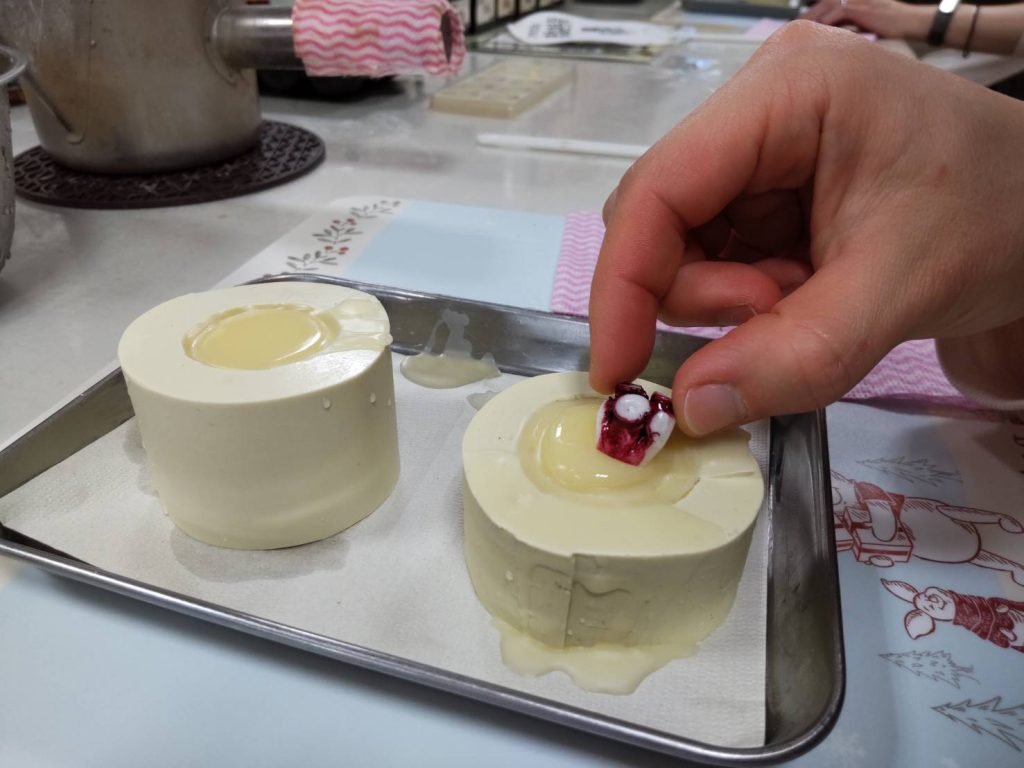
We added a bit of wax into the mold and stick in the ”tako!”
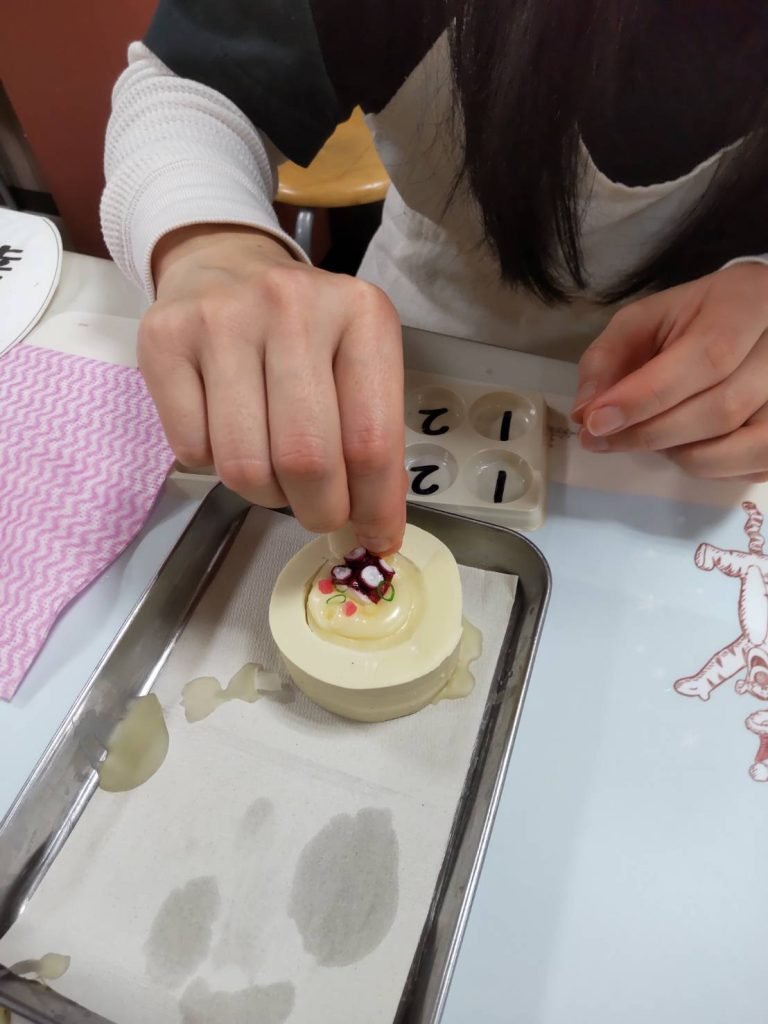
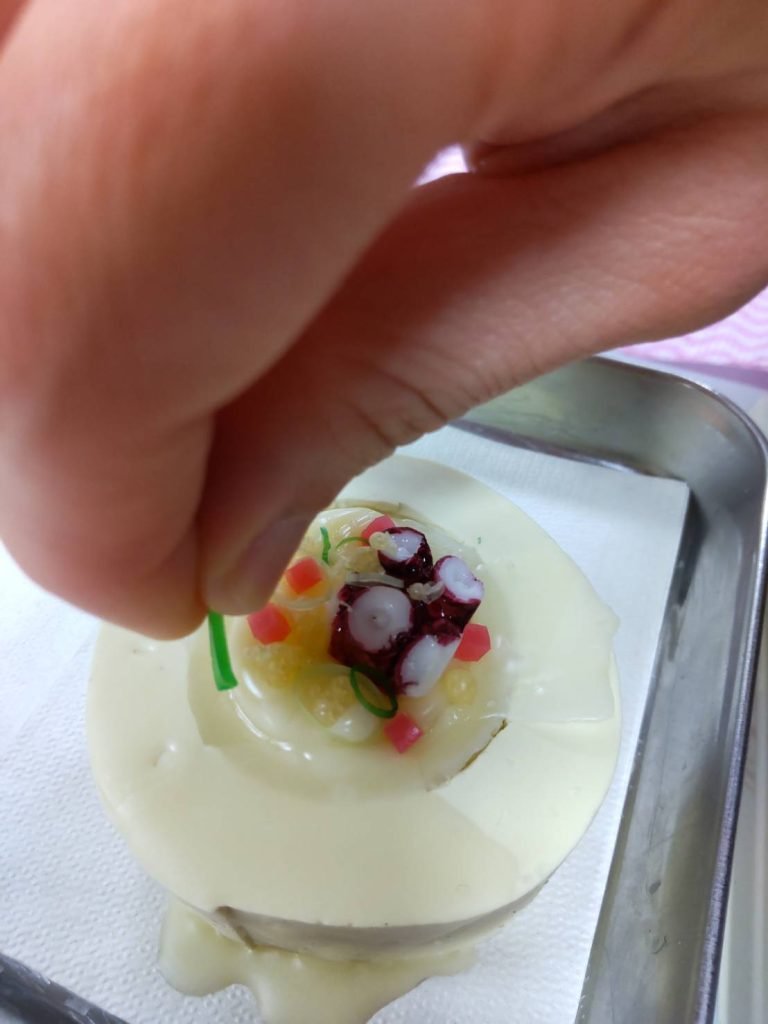
You have to add some other flecks and bits so you can get a realistic look!
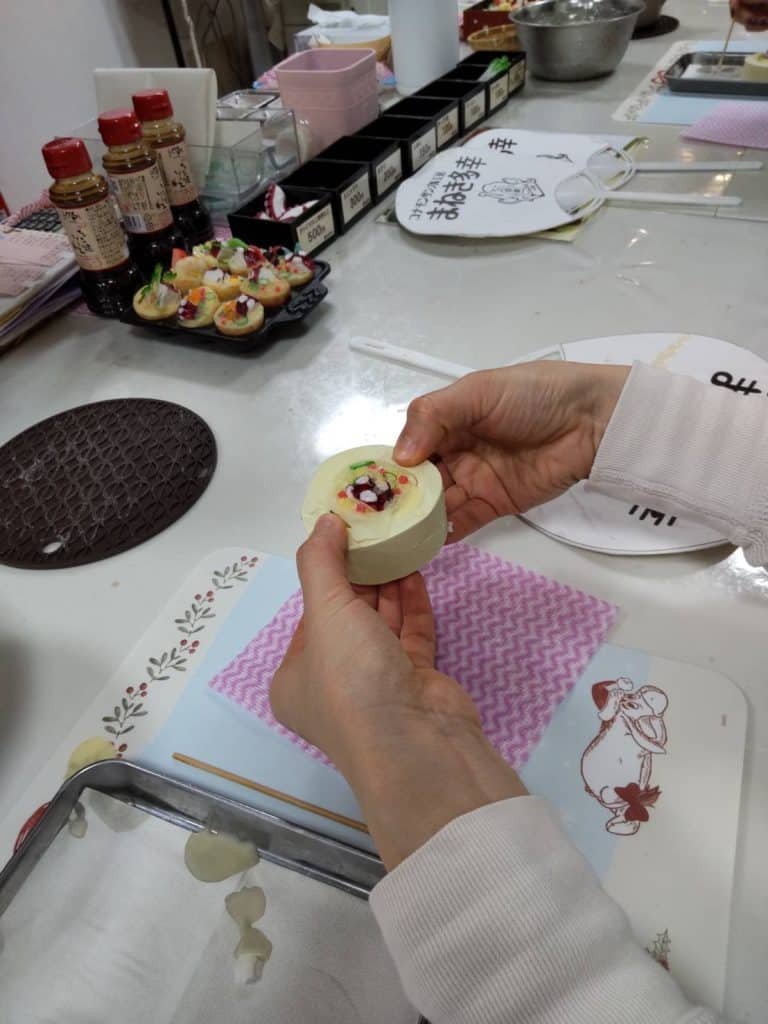
And once that’s dry you pop it out of the mold! ↓
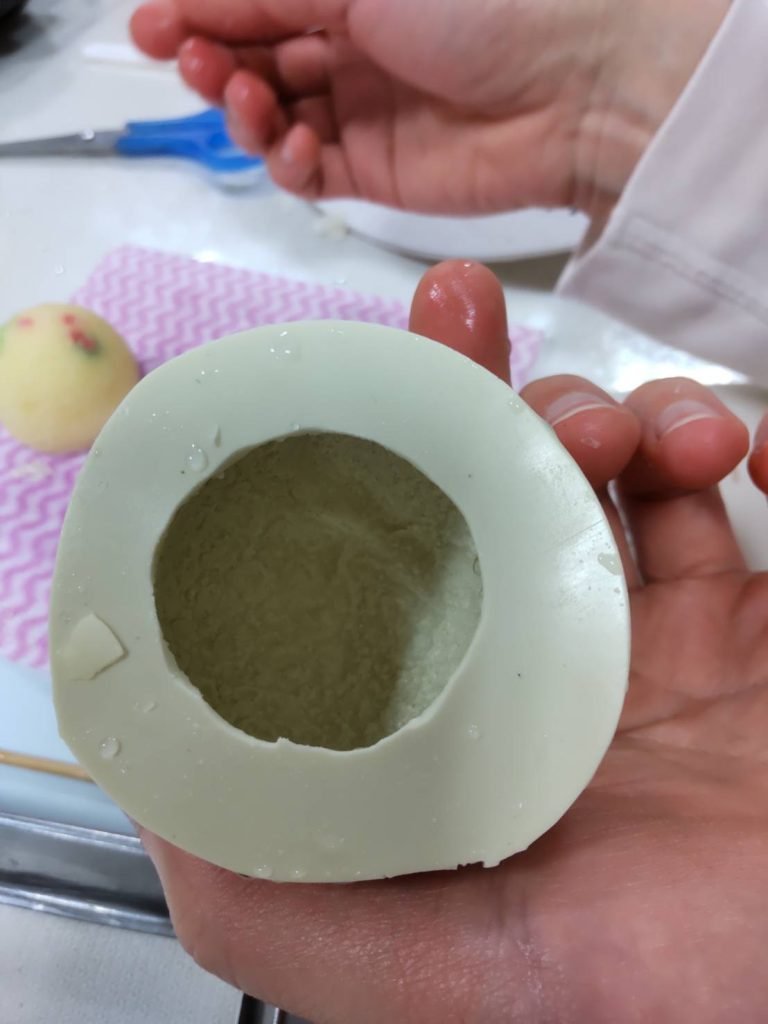
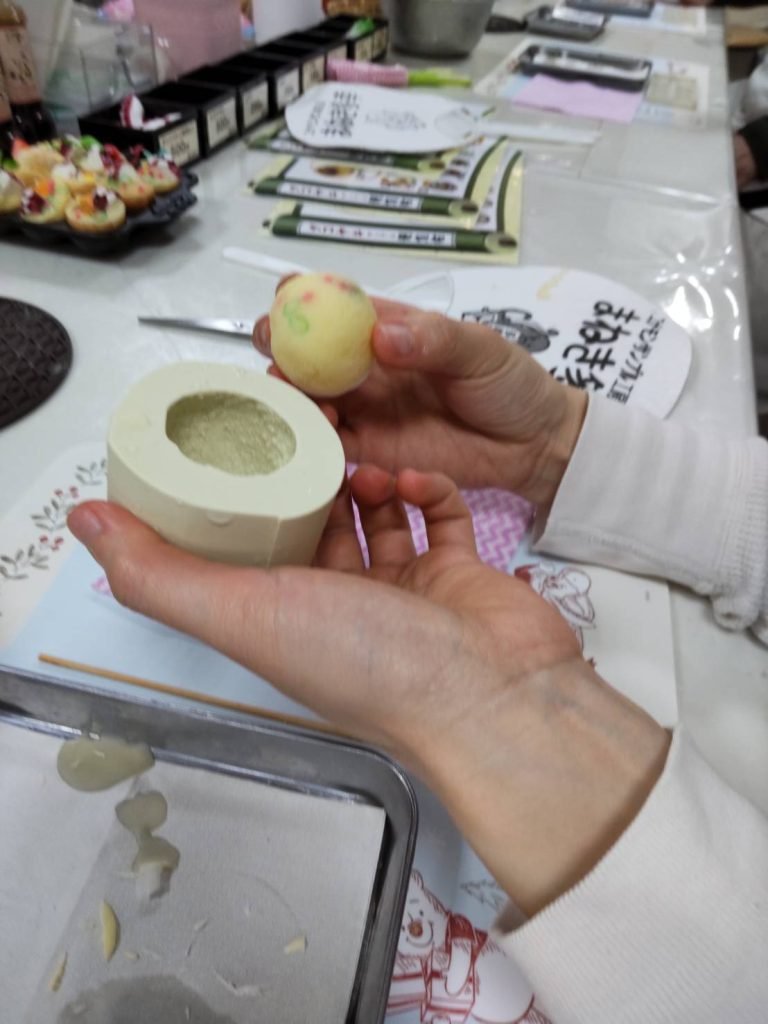
↓ Now we have to apply a brown paint to give it a “burnt” look! I was so excited to use the brown wax – this is the traditional method of making food replicas and it was so much fun! They were not cheaping out on ingredients, they’re doing it the real way!

Lets cool the balls! ↓
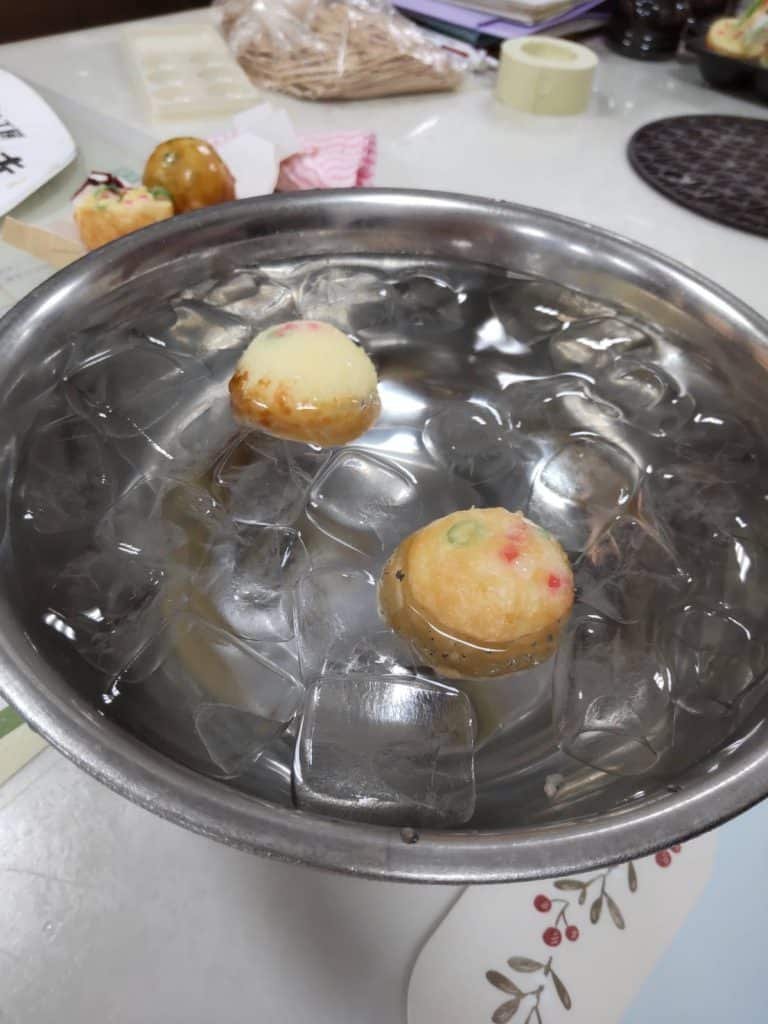
Now we can add a little takoyaki sauce! ↓ It’s made with gelatin and food coloring! “Is it edible?” we asked but they said “it’s not recommended.” (Darn!)
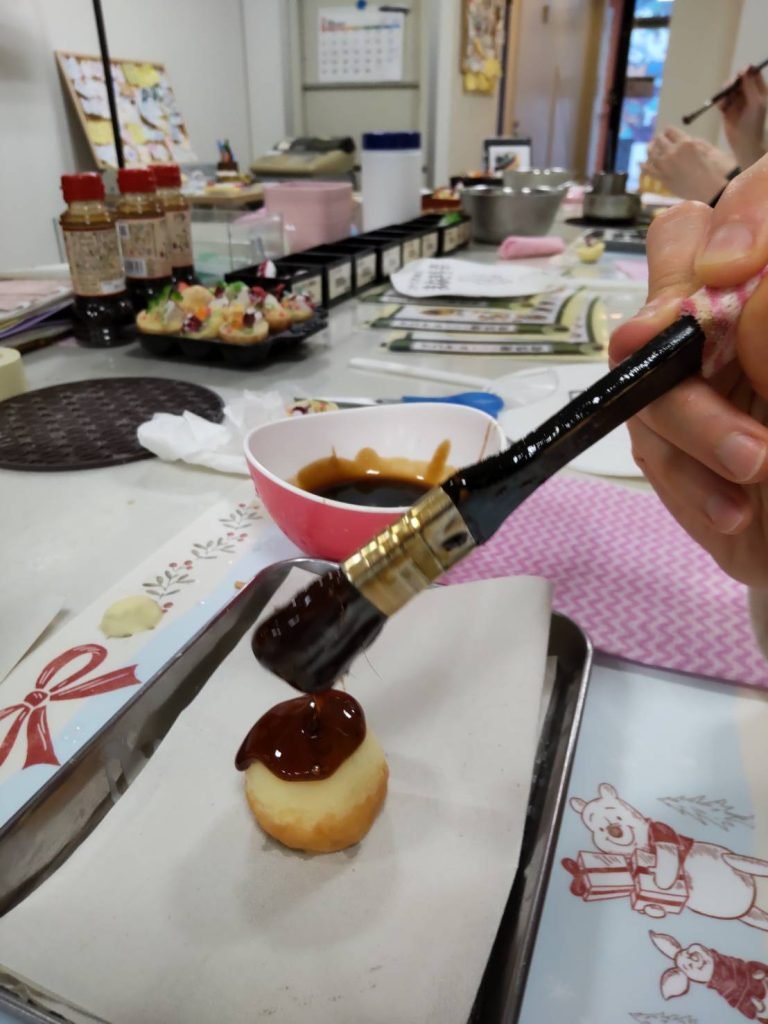
Now it’s time to add some incredibly realistic looking katsuo flakes and nori powder to give it a delicious touch! ↓
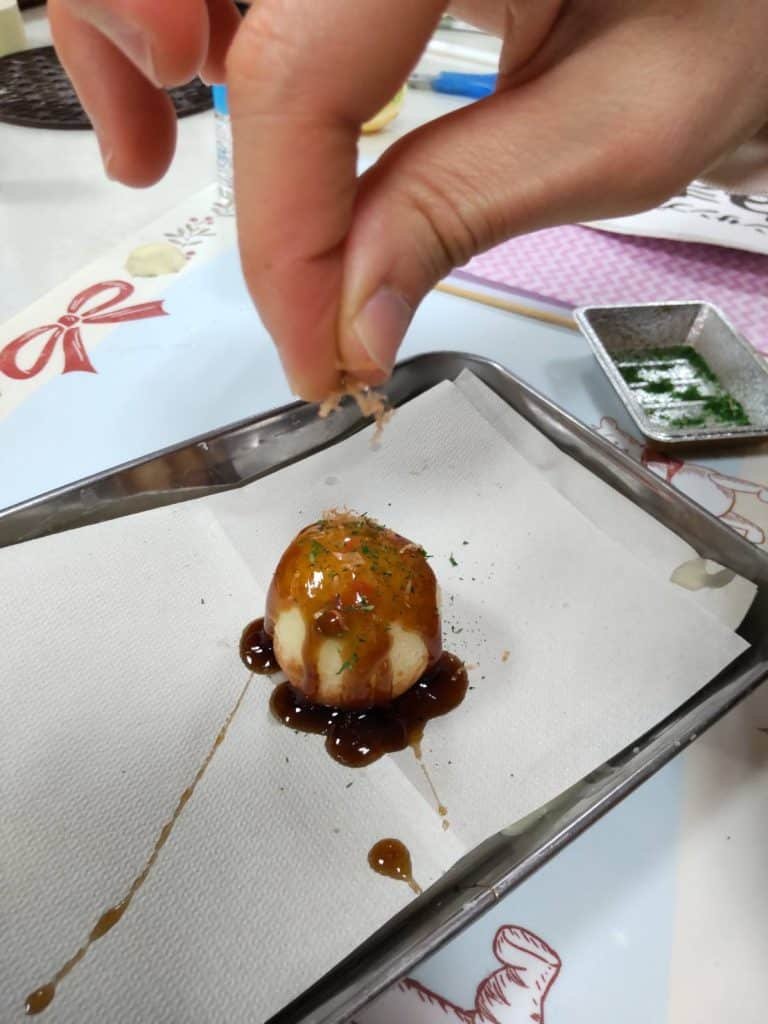
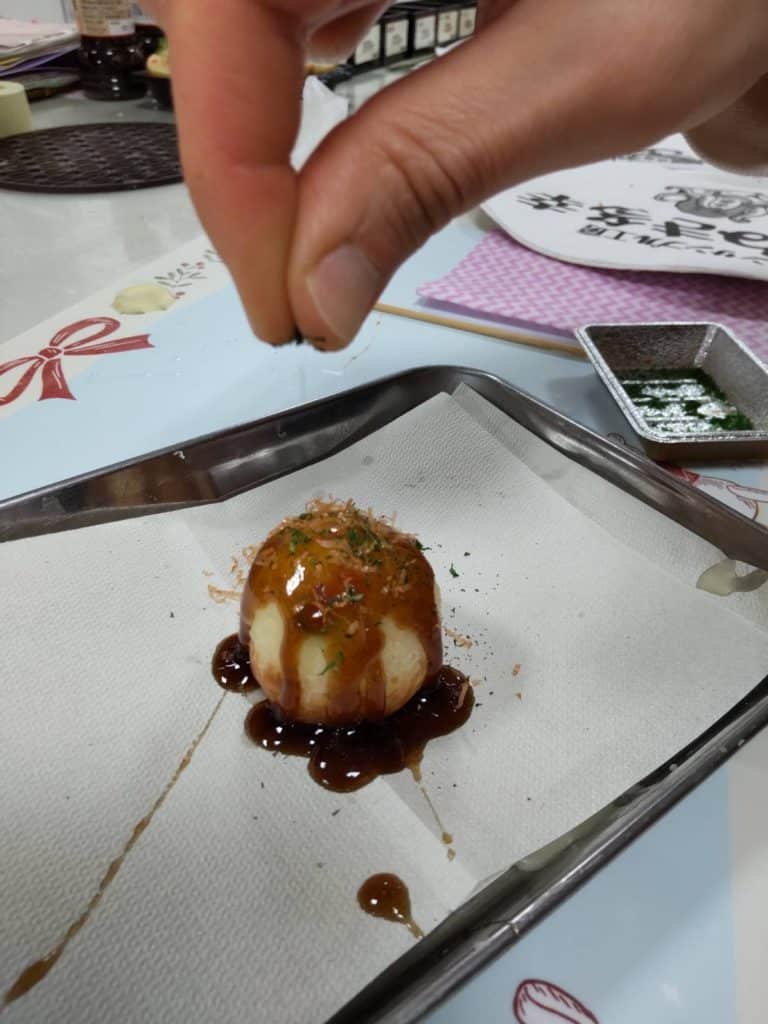
Once the takoyaki was finished we got a nice case to put it in so that no dust would stick to it! ↓
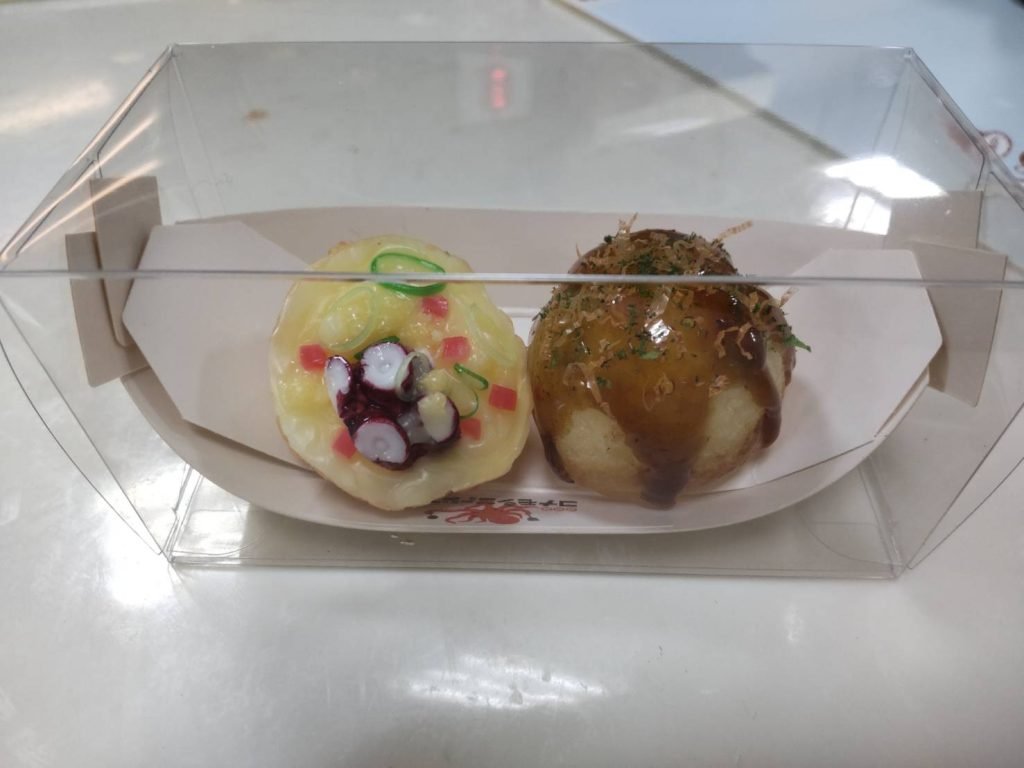
Not only that but we received their original sauce which you can’t buy anywhere else! What an amazing value!
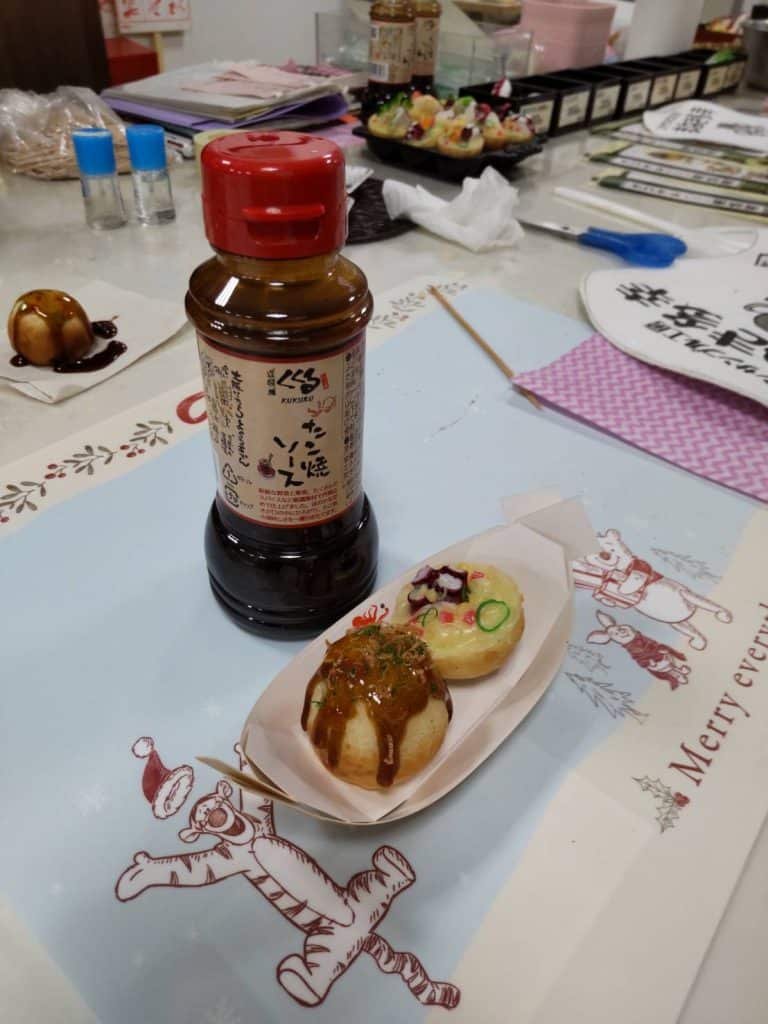
We originally thought the bottle was made of wax but “THIS one you can eat,” they said ↑
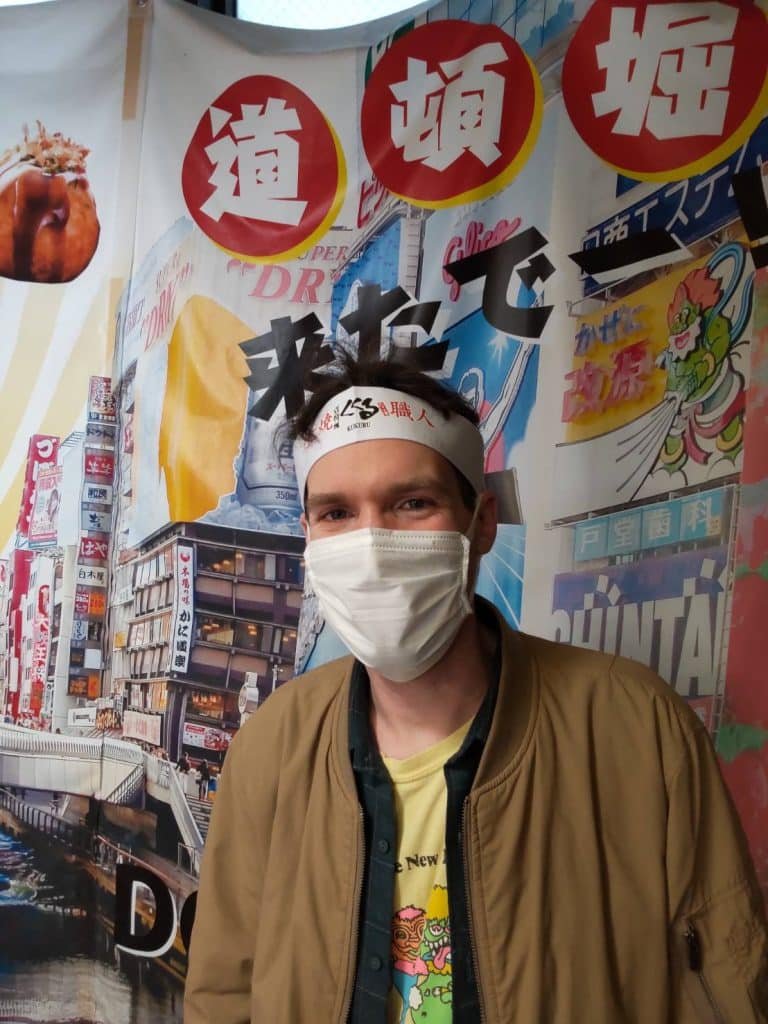
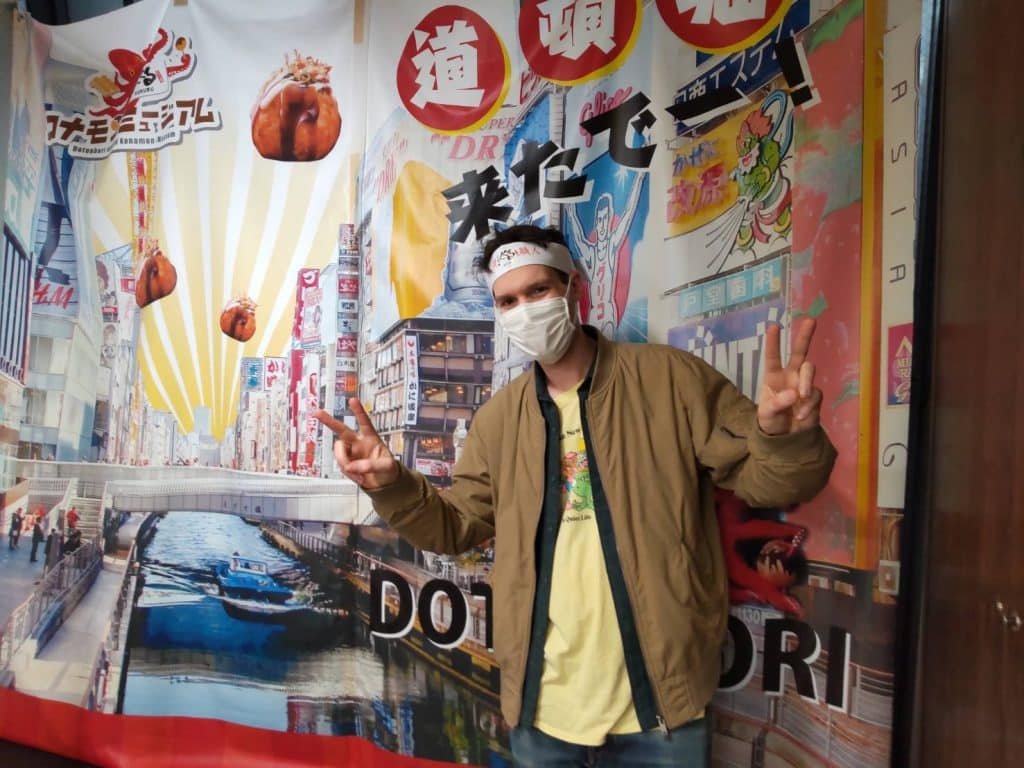
On days when sauce is not available they have this original “hachimaki” gift. (And who is this cool guy modeling it for us???) They said to make sure to mention it’s not in stock at the moment! But who knows, the next time you visit you might get lucky!
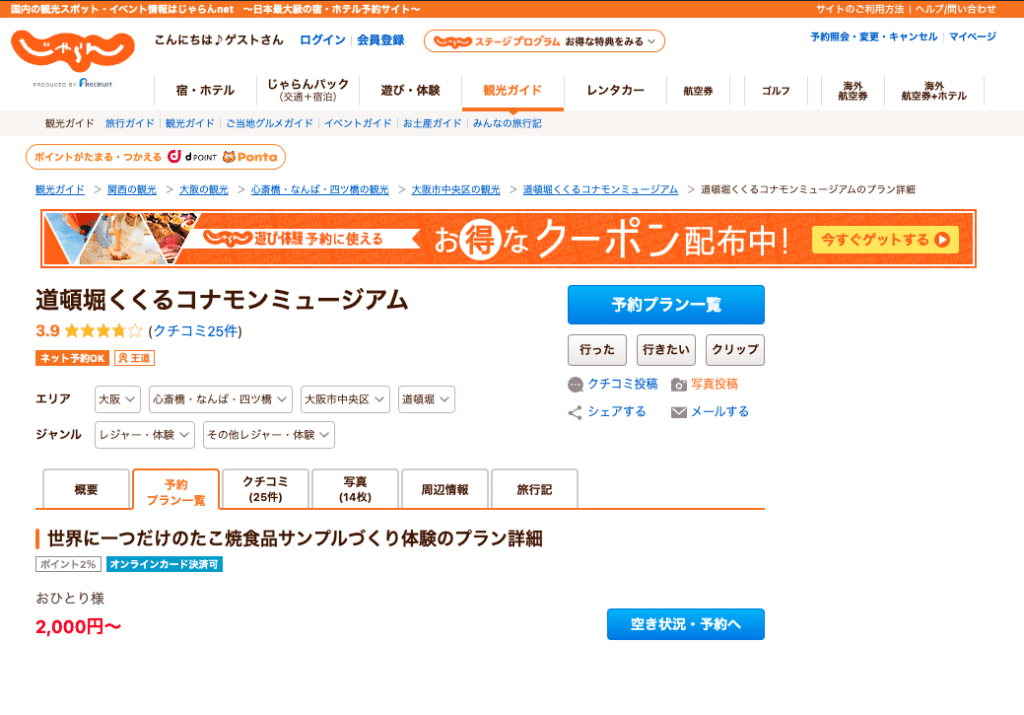
You can visit site “Jalan” ↑ to make reservations to make some takoyaki yourself, but you need to grab a Japanese friend to help you, it’s not very English friendly!
A few more food replica pics I like

I like this retro cream soda, it’s very realistic! I like how the ice cream hasn’t melted and looks like it’s stopped in time! Some food samples have the melted ice cream (as you can see below) look but I prefer this one!
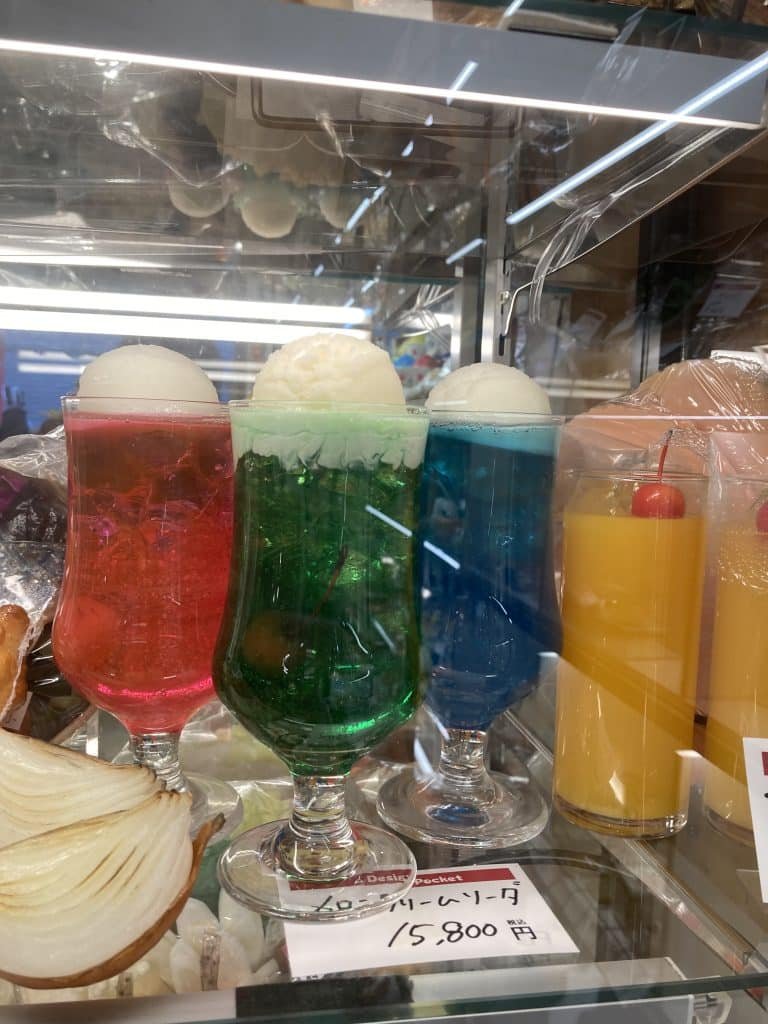
They even have food samples at Osaka souvenir shops! ↓
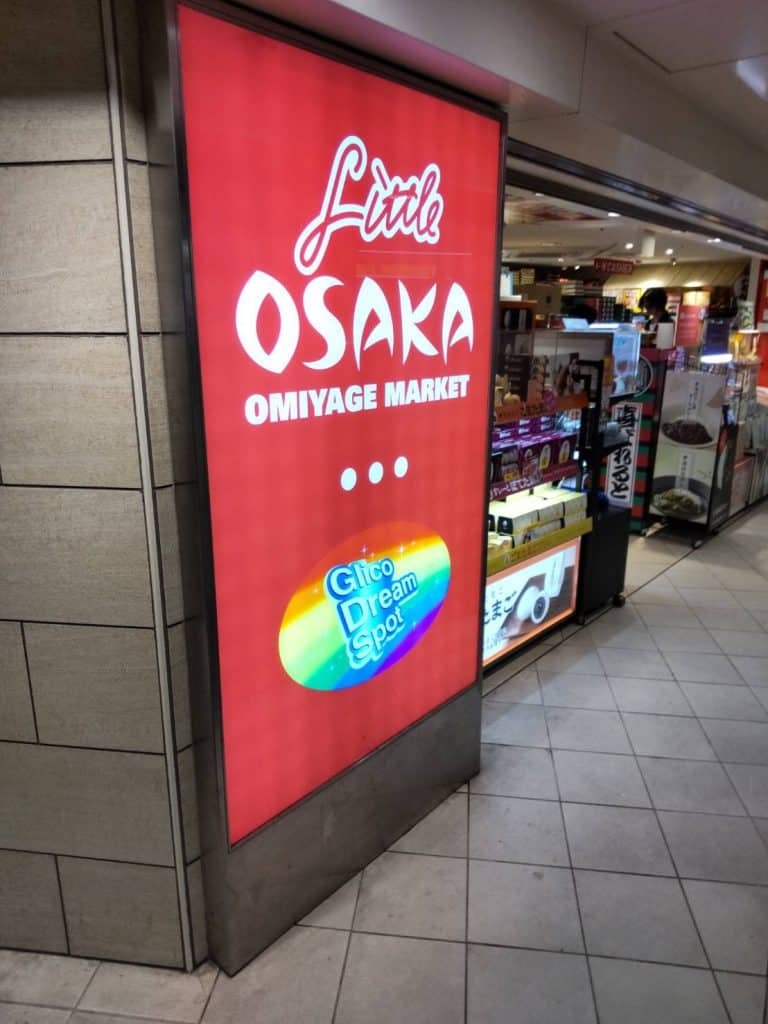
It’s near the Namba station.
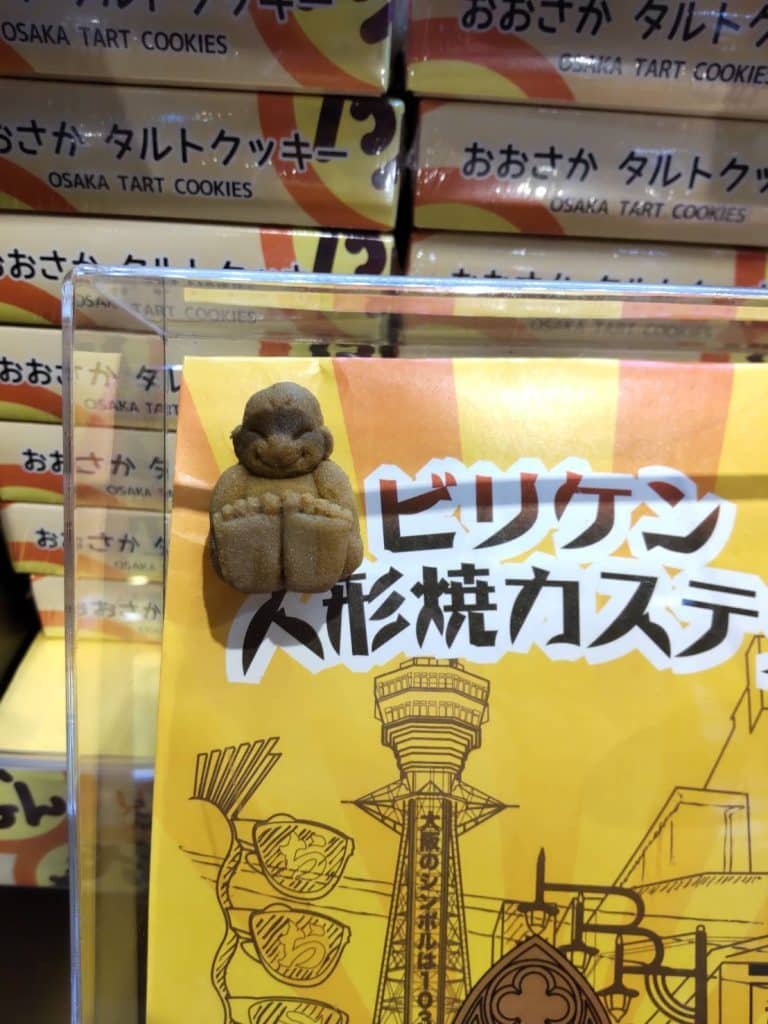
This is the famous ”Biliken” character as a mini castella food replica. It’s so cute, I had to take a picture!
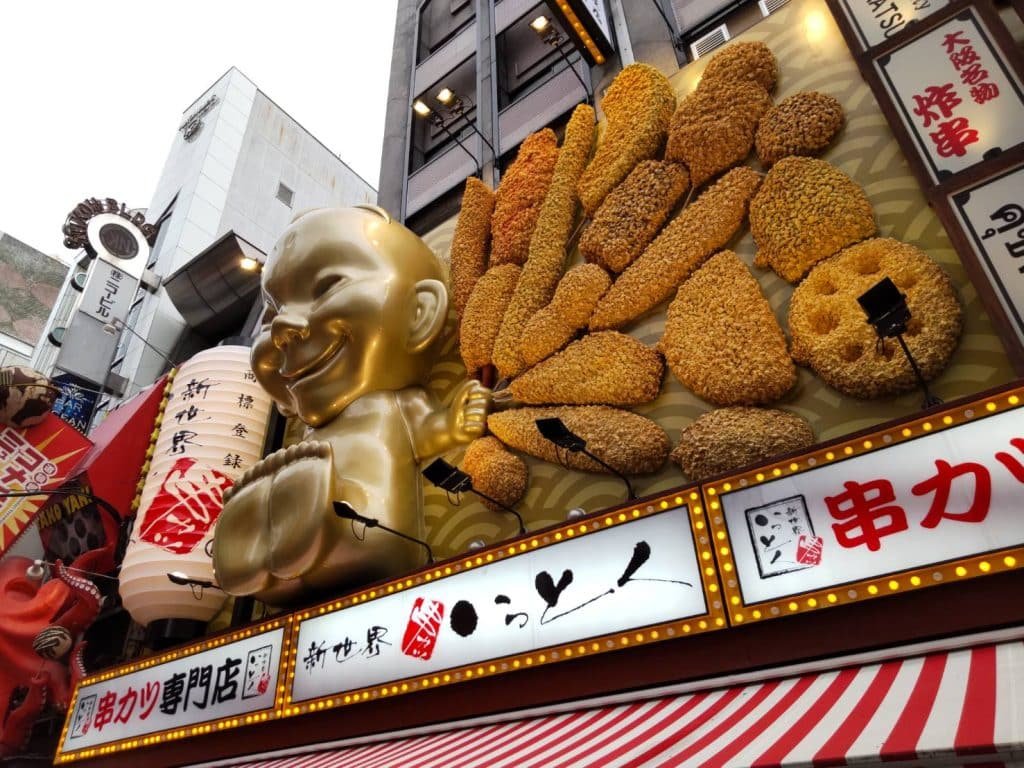
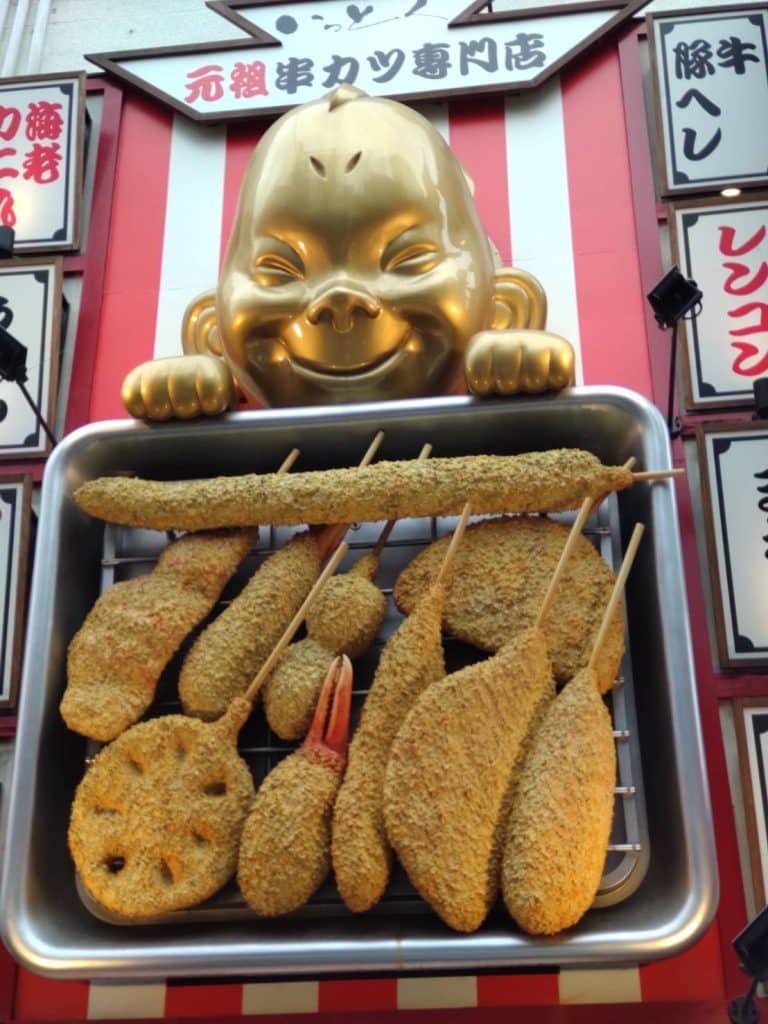
You can see him all over Namba next to the giant shokuhin samples!
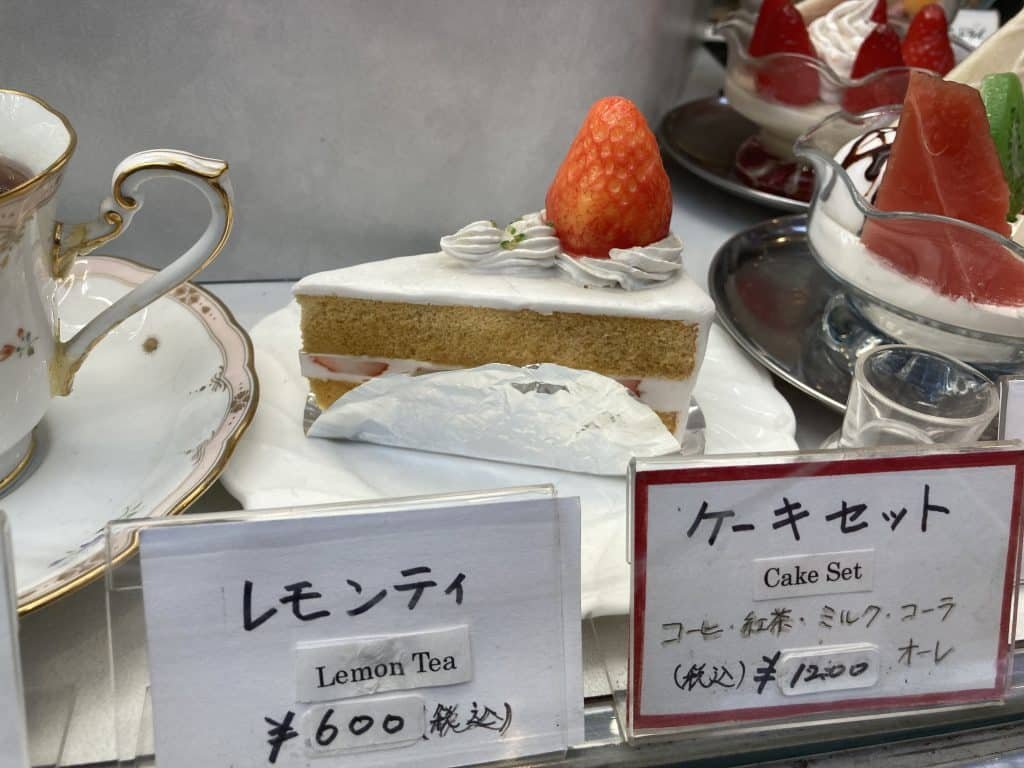
I like this lemon tea sponge cake because it looks so real. I like the added touch of using the aluminum foil – they make it look so appetizing! It’s from Junkissa American!

It’s my favorite show window/favorite shokuhin sample of all that I saw today! It’s got the classic retro style that remains unchanged! Everything is very well made and I love the display.
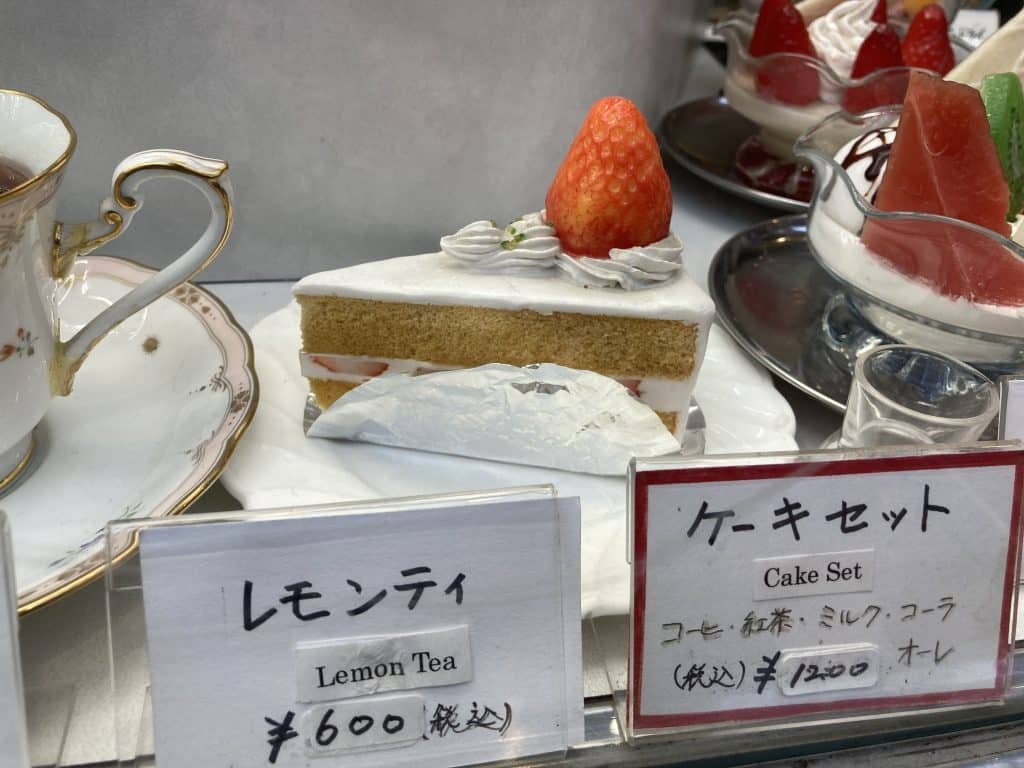
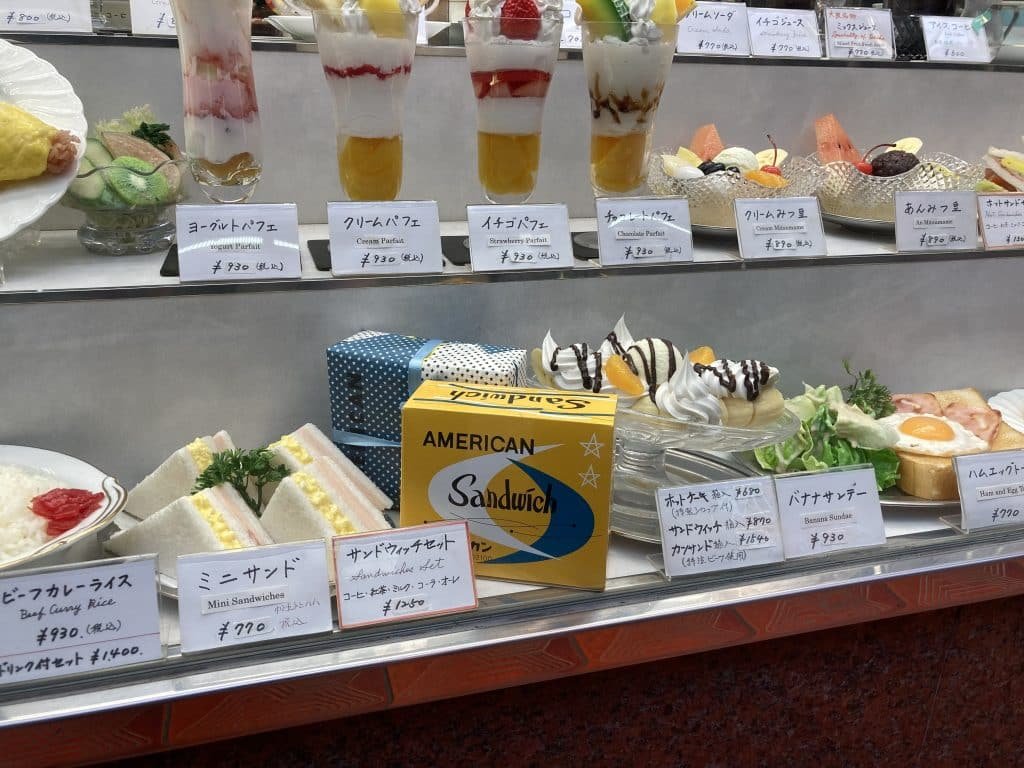
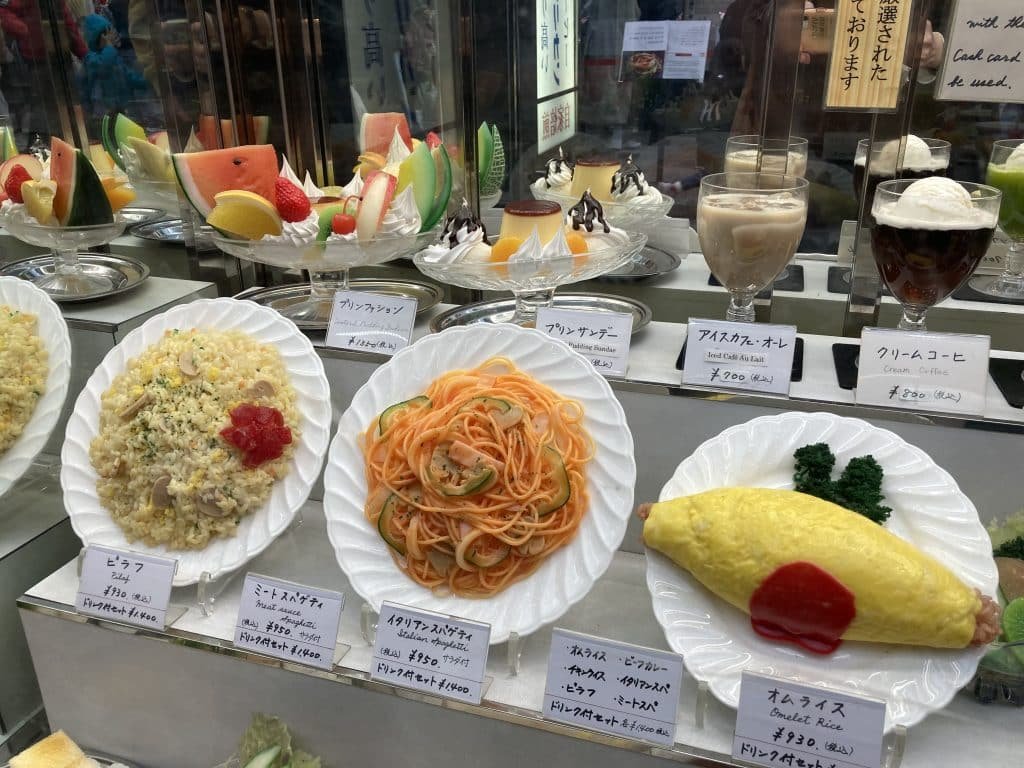
That’s it for today’s adventure! I look forward to the next one, stay tuned!





















genius!
Thanks!
This makes me want to visit Japan even more!
Yes, please visit Japan someday! Thank you for reading!!
Very interesting Nagisa!! I learned a bunch! Thank you!
Thank you for reading, Mindy!:D
Thank you for this informative article? Do you think the Design Pocket and Konamon Museum classes would be ok for people who don’t speak Japanese? Both their websites seem to be catered to Japanese speakers.
Thanks for this interesting article! Do you think the Design Pocket and Konamon Museum classes would be ok for people who don’t speak Japanese?
Hi, Clare! Thank you for reading my article! I will try to ask Konamon museum if they can make their website in English too. also the class has instruction for English speaker so it was very helpful. Thank you!!